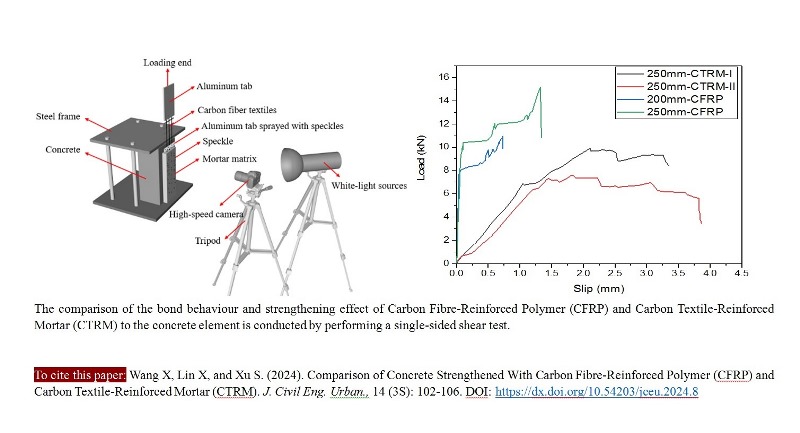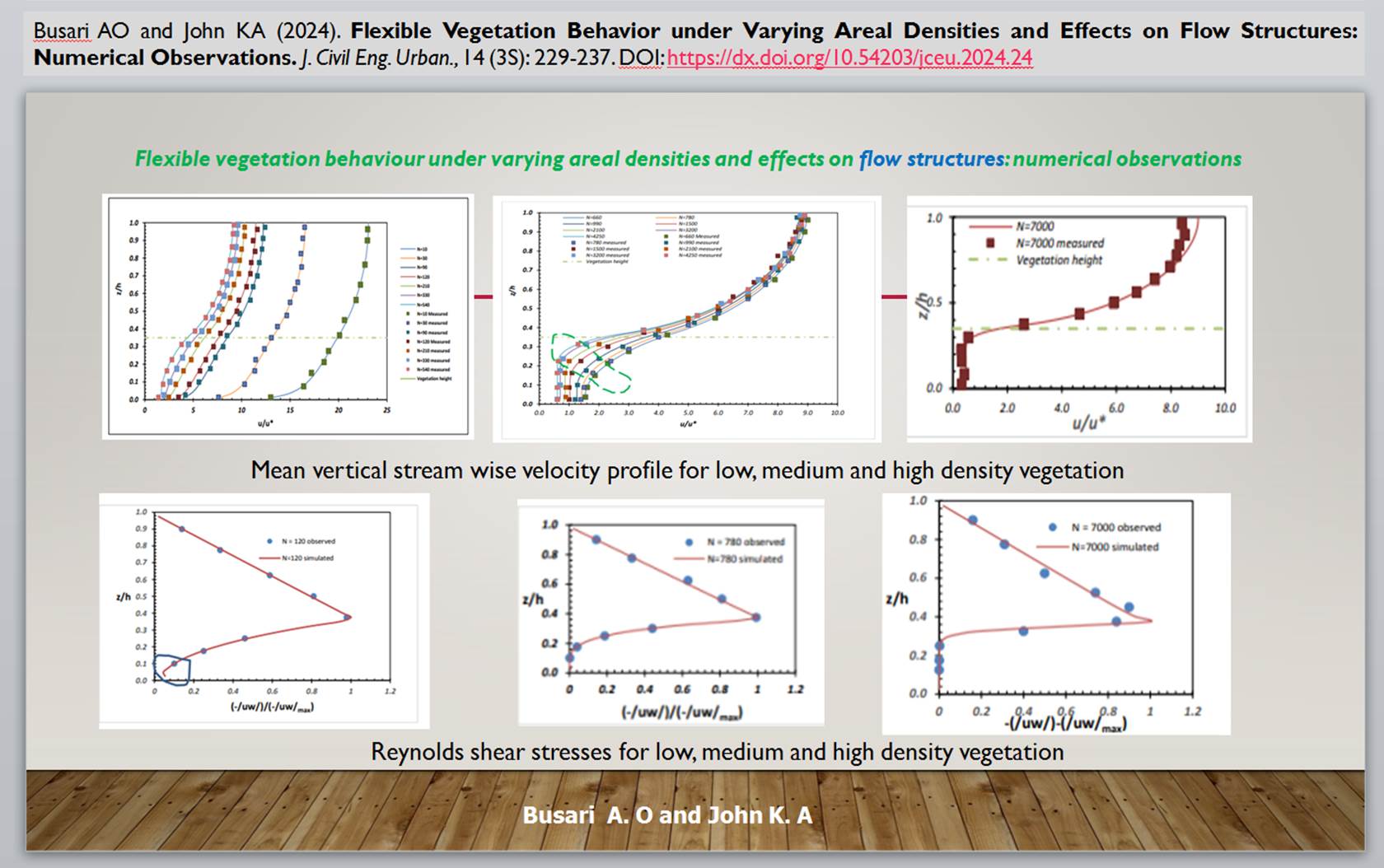Most read content
Partner Journal
<Previous issue | Next issue> | Archive
Volume 14 (3S); 15 Sep, 2024 [Booklet] [ICCESR-2024]
|
|
Research Paper
Comparison of Concrete Strengthened with Carbon Fibre-Reinforced Polymer (CFRP) and Carbon Textile-Reinforced Mortar (CTRM)
Wang X, Lin X, and Xu S.
J. Civil Eng. Urban., 14(3s): 102-106, 2024; pii:S225204302400008-14
DOI: https://dx.doi.org/10.54203/jceu.2024.8
Abstract
Applying new composite material for strengthening and repairing existing structures is an important research topic. Carbon Fiber Reinforced Polymer/Plastics (CFRP) and Carbon Textile Reinforced Mortar (CTRM) are two common structural external reinforcement materials. 18 concrete specimens strengthened with CFRP and CTRM are prepared in this study. The quasi-static single-sided shear tests combined with the Digital Image Correlation (DIC) method is applied. The results show that the interface bonding strength of CFRP strengthening (0.76-0.96 MPa) is 65.0% to 74.8% higher than the CTRM-concrete interface (0.43-0.63 MPa). The ductility and energy dissipation capacity of CTRM strengthening is better than that of CFRP strengthening, and the effective bonding length is 125 to 300 mm. In practical work, CFRP is preferred for improving the strength of concrete components, while CTRM is preferred for improving ductility and seismic resistance.
Keywords: Carbon fibre-reinforced composites (CFRP); Carbon textile-reinforced mortar (CTRM); Digital image correlation method (DIC); Single-sided shear test
[Full text-PDF] [Crossref Metadata] [Export from ePrints]
|
|
Research Paper
Effects of Blended Portland-Fly Ash Cement on Compressive Strength of Seawater Mixed and Cured Lateritic Concrete
Alabi SA, Arum C, Akande AR, Mahachi J, and Afolayan JO.
J. Civil Eng. Urban., 14(3s): 107-112, 2024; pii:S225204302400009-14
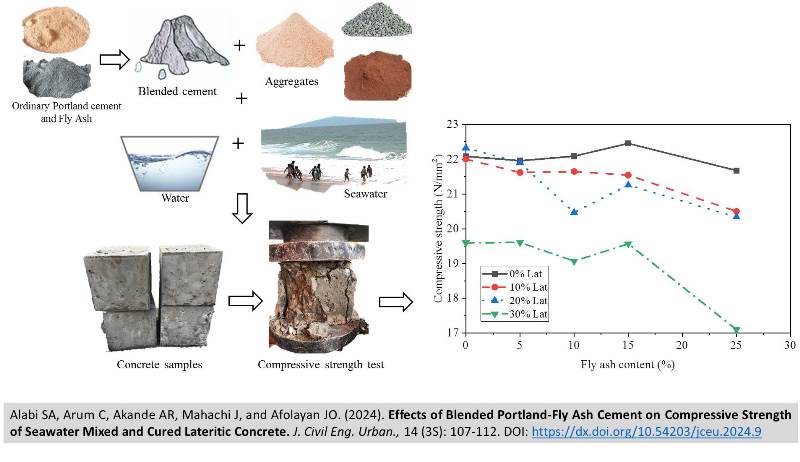 DOI: https://dx.doi.org/10.54203/jceu.2024.9
DOI: https://dx.doi.org/10.54203/jceu.2024.9
Abstract
The use of cement in the construction industry is accompanied by the release of greenhouse gases (GHGs) into the ecosystem, and freshwater usage is on the rise globally, putting the world in a potential freshwater scarcity. This study investigated the effects of blended Portland-fly ash cement on the compressive strength of seawater-mixed and cured lateritic concrete by partially replacing the concrete materials: cement with fly ash at 0%, 5%, 10%, 15%, and 25%; fine aggregate, with laterite at 0%, 10%, 20%, and 30%. A concrete mix ratio of 1:1.5:3 was used in the production of concrete cubes with an expected target compressive strength of 20 N/mm2. The compressive strength of the cubes was measured at 7, 28, and 56 days using standard testing procedures. Cubes cast with and cured in seawater (SW-SW) had strength values relatively higher than those cast with and cured in freshwater (FW-FW) at 28 days of curing. At 28 days, SW-SW cubes gave 22.44 N/mm2 while FW-FW cubes gave 21.80 N/mm2 as the highest strength values at 10% Lat and 10% FA. However, the FW-FW cubes had strength values higher than those of seawater mixed and cured concrete (SW-SW) at 56 days. FW-FW cubes gave 26.82 N/mm2 while SW-SW cubes gave 26.34 N/mm2 as their highest strength values at 10% Lat and 10% FA. Generally, an increase in fly ash and laterite content significantly reduces the compressive strength of concrete. Overall, seawater is recommended for curing and mixing, especially in non-reinforcing concrete. 10% fly ash and 10% laterite are also recommended for use in blended Portland cement-fly ash concrete as they give the highest strength values.
Keywords: Concrete, Fly Ash, Laterite, Seawater, Compressive strength
[Full text-PDF] [Crossref Metadata] [Export from ePrints]
|
|
Research Paper
Statistical Evaluation of the Geometric Properties Steel Bars for Reinforced Concrete in Botswana
Adewuyi AP, and Eric GB.
J. Civil Eng. Urban., 14(3s): 113-122, 2024; pii:S225204302400010-14
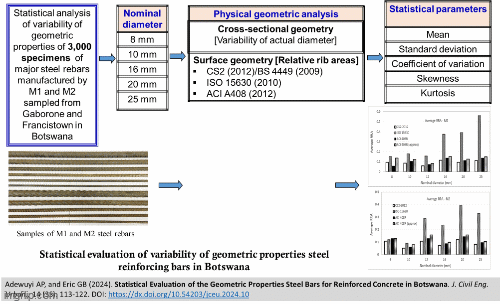 DOI: https://dx.doi.org/10.54203/jceu.2024.10
DOI: https://dx.doi.org/10.54203/jceu.2024.10
Abstract
Uncertainties in construction materials, especially steel reinforcing bars, have multiplying adverse impacts on the integrity and reliability of constructed facilities from construction to service life stages. Botswana depends on importation of rebars to meet the ever-increasing demands for buildings and reinforced concrete civil infrastructure. The study assessed the mass and geometric properties of the two most utilized steel reinforcing bars, designated as M1 and M2, in Botswana. With the aid of digital analytical balance and Vernier calipers, measurements of mass per unit length and the relative rib area (RRA), which depends on nominal diameter, rib height, rib spacing, and longitudinal rib or gap thickness were made from 3000 standard bars each of nominal sizes from 8 mm to 25 mm randomly sampled at the suppliers’ depots/warehouses and various construction sites in Gaborone and Francistown. The RRA is a measure of the surface geometry for interfacial bonding between steel reinforcing bar and the surrounding concrete. The geometric properties of each steel bar type of the nominal sizes were characterized in terms of the statistical parameters and compared for compliance with standard specifications such as CS2 (2012), ISO 15630, ACI A408. The actual mass and diameter of bars were within the tolerance of ± 1% of the respective nominal size which satisfied all the standard requirements. Only the 8 mm diameter M2 bars did not have longitudinal ribs/gaps. ACI specifies a range of 0.10 to 0.14 for RRA, while CS2/ISO 15630 only specifies for the minimum RRA values of 0.040 for 8 to 12 mm bars and 0.056 for 16 to 25 mm bars. M2 bars of 10 mm dia. bars did not satisfy CS2/ISO 15630 requirements. However, M1 (8 mm and 12 mm) and M2 (10, 16 and 25 mm) bar sizes are below the minimum and M2 bars of 20 mm diameter are above the recommended RRA values of ACI A408. These would reduce the load carrying capacity of RC members reinforced with the unsatisfactory bar sizes.
Keywords: Surface geometry, reinforcing bars, relative rib area, interfacial bonding, statistical indices, load carrying capacity.
[Full text-PDF] [Crossref Metadata] [Export from ePrints]
|
|
Research Paper
Enhancing Structural Application: Assessing the Suitability of Sawn and Glue Laminated Albizia zygia (Ayunre) Timber for Sustainable Construction
Ekundayo OO, Arum C, and Shittu LT.
J. Civil Eng. Urban., 14(3s): 123-131, 2024; pii:S225204302400011-14
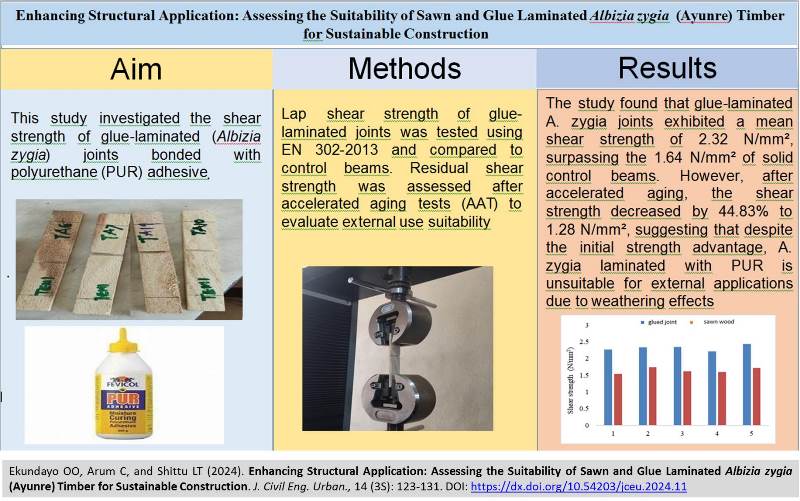 DOI: https://dx.doi.org/10.54203/jceu.2024.11
DOI: https://dx.doi.org/10.54203/jceu.2024.11
Abstract
Leading economies are moving towards a bio-based economy for sustainability, but Africa struggles to utilize its bio- resource such as timber for advanced engineering application due to its natural limitations. Nevertheless, glue lamination (glulam) is promising for enhancing wood for structural application. Hence, this study investigated the shear strength of glue laminated (glulam) joints of Albizia zygia (A. zygia) timber species bonded with polyurethane (PUR) adhesive and other essential physical and mechanical properties in line with relevant standards. Briefly state the methodology before results to ensure flow. The results showed that the mean density of the wood species is 519 at a mean moisture content of 12%. The wood recorded a mean volumetric shrinkage and volumetric swelling of 1.17% and 6.52% respectively. Other properties include mean bending strength at 53.89 , mean stiffness at 6106 N/mm2, compressive strength parallel to grain at 32.70 and mean tensile strength at 33.61 . Furthermore, the lap shear strength for glue laminated joints was tested according to EN 302-2013 standard and compared to control solid beams. The mean shear strength for glulam was 2.32 while it was 1.64 for the control beams. Thus, the glued joints performed better in shear than the control specimen. Finally, the residual shear strength of the joints was a mean value of 1.28 after subjecting them to accelerated aging tests (AAT). This is equivalent to 44.83% decrease of the shear strength in the dry use state. Hence, glue laminated A. zygia using PUR is not suitable for external use due to weathering effects on its shear strength. Based on the findings in this study, A. zygia is a moderately dense wood suitable for structural use but for interior application when laminated with PUR. It is shown that locally sourced A. zygia can be enhanced through glue lamination for structural joints in service class 2 according to Eurocode 5.
Keywords: Glued joints, adhesives, Polyurethane, Tensile shear strength and Albizia zygia
[Full text-PDF] [Crossref Metadata] [Export from ePrints]
|
|
Research Paper
The Integration of Geographic Information Systems and Building Information Modelling to Sustainably Manage Development Sites in Gaborone, Botswana
Moreri K, Segobye M, Maphale L and Onneng B.
J. Civil Eng. Urban., 14(3s): 132-141, 2024; pii:S225204302400012-14
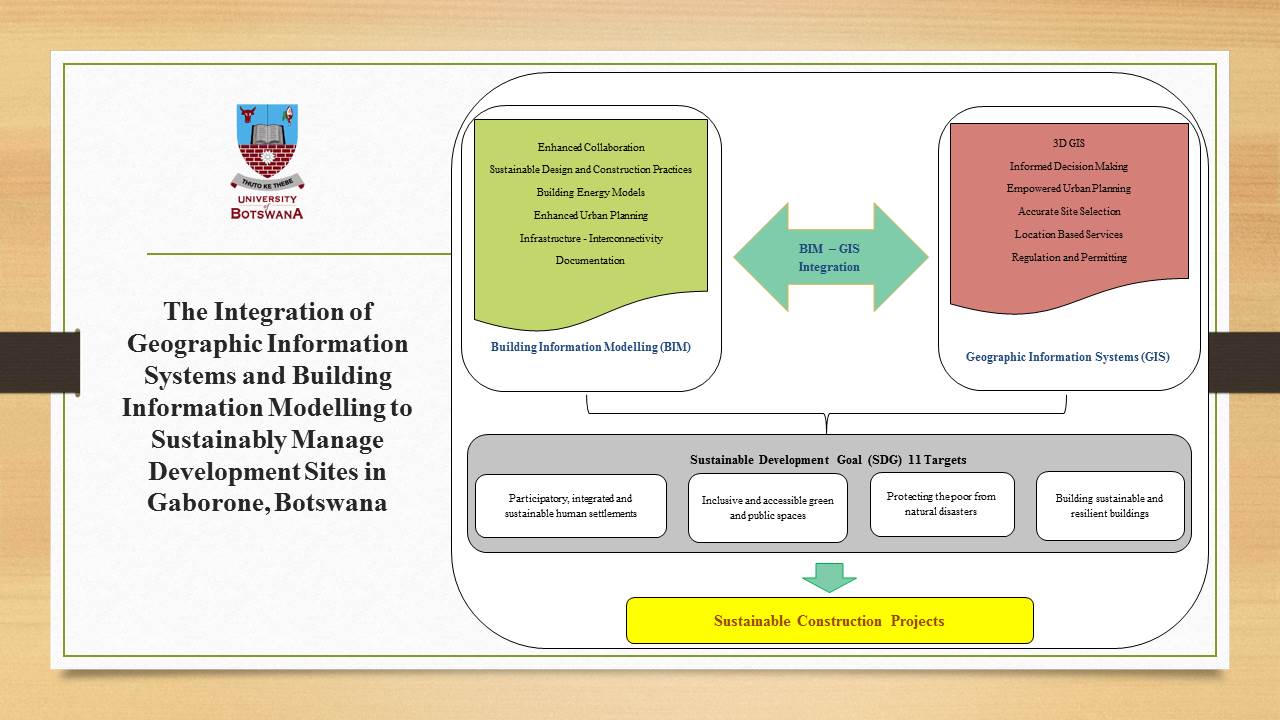 DOI: https://dx.doi.org/10.54203/jceu.2024.12
DOI: https://dx.doi.org/10.54203/jceu.2024.12
Abstract
For many years, site development professionals and urban planners have worked in silos, yet they share a similar objective of providing a better built and natural environment. Moreover, there seems to be a stereotype in terms of focus areas; with urban planners more on the macroscale while their site development counterparts are more on the micro end. The two professional groups speak in different languages and use different instruments. For example, urban planners have introduced Geographic Information Systems (GIS) while site development professionals like architects, engineers, contractors, and facility managers advocate for Building Information Modelling (BIM). The increasing complexity of site development, their related environmental, geographical, and surrounding infrastructure is highly desired to support informed decision-making. Advancements in computer science and data technologies can make this integration easier. However, the understanding of GIS and BIM integration is still in its infancy, as innovative applications of their fusion is yet to be explored comprehensively. Therefore, this study investigates how GIS and BIM can be integrated to derive big data to support site development in Gaborone, Botswana. It will further propose a conceptual framework for integrating BIM and GIS for better site development and sustainable urban management in Gaborone.
Keywords: Building Information Modelling, Geographic Information Systems, Sustainable Urban Management, Sustainable Construction Projects, BIM-GIS Integration, Conceptual Framework
[Full text-PDF] [Crossref Metadata] [Export from ePrints]
|
|
Research Paper
Comparative Analysis of Statistical Models for Predicting the Properties of Agricultural Waste-Enhanced Sandcrete Blocks
Odeyemi SO, Adisa MO, Kenku KO, Yusuf SA, Amuda MA, and Oladejo SO.
J. Civil Eng. Urban., 14(3s): 142-148, 2024; pii:S225204302400013-14
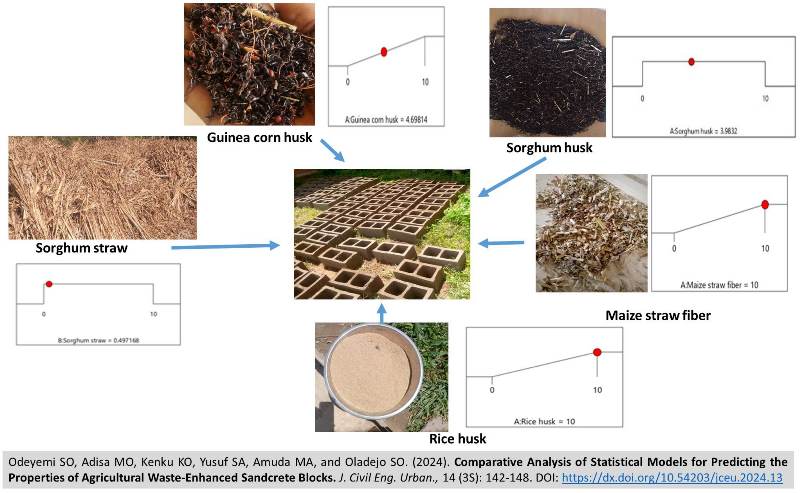 DOI: https://dx.doi.org/10.54203/jceu.2024.13
DOI: https://dx.doi.org/10.54203/jceu.2024.13
Abstract
Sandcrete blocks represent an indispensable building material, primarily composed of sand, water, and cement as a binding agent. Given the significant cost associated with cement, there is a need to produce low-cement blocks that are economically viable and cost-effective. This challenge has prompted the exploration of alternative materials to reduce cement content, simultaneously addressing environmental pollution and health risks associated with agricultural waste in rural areas. Notable examples of such alternative materials include various agricultural waste components. The primary objective of this research is to establish statistical models for predicting the compressive strength of blocks reinforced with rice husk, guinea corn husk, maize straw, and a combination of sorghum husk and straw. The research findings indicate that the density of fibre-reinforced blocks decreased as the quantity of fibre increased. Furthermore, the compressive strength of the sandcrete blocks decreased as the fibre content increased. However, compressive strengths of 2.41 N/mm², 1.90, 2.40 N/mm², and 3.01 N/mm² were achieved for rice husk, guinea corn husk, maize-straw, and a combination of sorghum husk and straw-reinforced sandcrete blocks, respectively. Only sandcrete blocks with sorghum husk and straw met the Nigerian Industrial Standard specifications (NIS 87:2000). A water-binder ratio of 0.4 was determined as optimal for all the blocks under investigation. Four models with precision values higher than 4.0 were generated to predict the compressive strengths of the blocks. This research represents a valuable contribution to developing environmentally friendly building materials for the construction industry.
Keywords: Agricultural waste; Sandcrete blocks; Statistical models; Straw.
[Full text-PDF] [Crossref Metadata] [Export from ePrints]
|
|
Research Paper
Mapping Buildings from Semi-Informal Settlements Using Non-Parametric Classifiers: A Case of Old Naledi
Mpoeleng W, Segobye M, Ouma Y, Moreri K, Manisa BM, Nkwae B, Maphale L and Nkhwanana N.
J. Civil Eng. Urban., 14(3s): 149-157, 2024; pii:S225204302400014-14
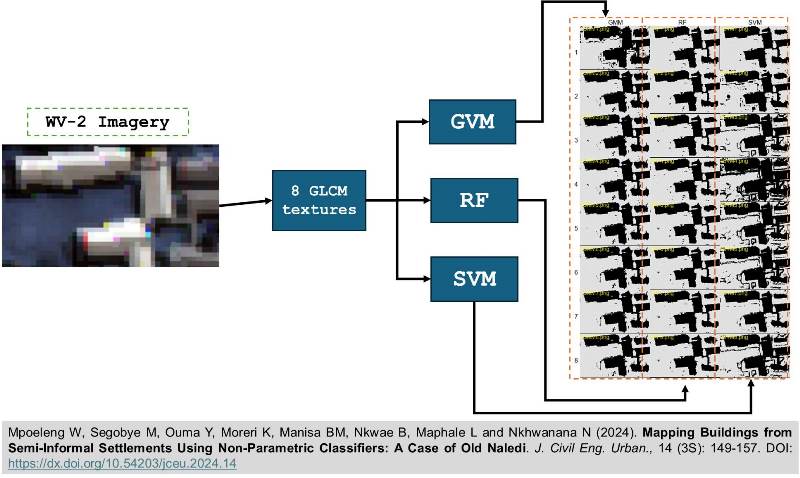 DOI: https://dx.doi.org/10.54203/jceu.2024.14
DOI: https://dx.doi.org/10.54203/jceu.2024.14
Abstract
Building footprints are essential for planning and designing new infrastructure like water reticulation, electricity transmission, sewer, and road networks. They are also necessary for delivery, census, and disaster management. It is therefore important to have up-to-date maps and GIS databases for service provision. However, mapping building of footprints in semi-informal settlements is problematic because of the spatial heterogeneity of settlements. This study evaluates three non-parametric machine learning algorithms for extracting building footprints from WorldView-2 (WV2) satellite imagery in a semi-informal settlement. WV2 satellite imagery data was fused with gray-level co-occurrence matrices (GLCM) to enhance building extraction. The algorithms used include the Gaussian Mixture Model (GMM), Random Forest (RF), and Support Vector Machine (SVM). The results indicate that GLCM does not improve the detection of buildings when using the GMM algorithm, but it increases building detection with RF and SVM. The GMM algorithm achieved the highest average accuracy of 92% for building detection. However, SVM and RF have an overall accuracy of 79% and 70% respectively. Though RF did not perform very well in identifying individual buildings, its overall accuracy was high. The outcome indicates that machine learning algorithms can adequately map building footprints from high-resolution satellite imagery.
Keywords: Building detection, WorldView-2, machine learning, Gray-Level Co-Occurrence Matrix (GLCM)
[Full text-PDF] [Crossref Metadata] [Export from ePrints]
|
|
Research Paper
Fluoride Concentration in Selected Water Sources of Ngamiland and Boteti Districts: Risk of Dental Fluorosis
Mfundisi KB, Marebole MK, and Kaisara K.
J. Civil Eng. Urban., 14(3s): 158-163, 2024; pii:S225204302400015-14
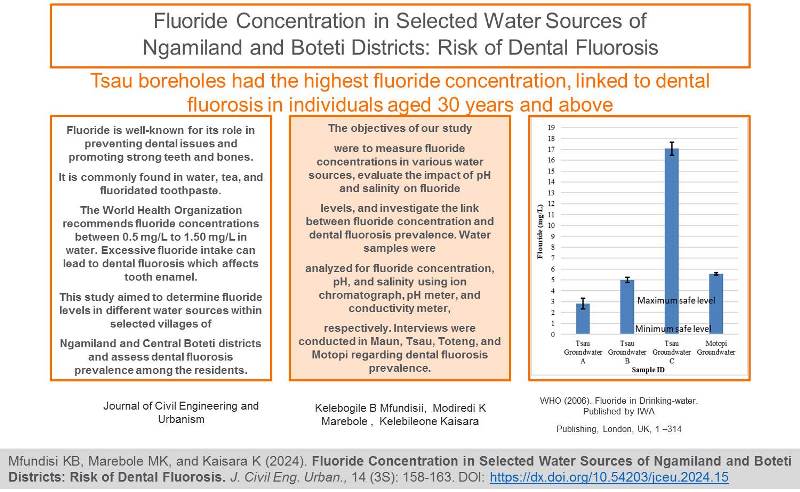 DOI: https://dx.doi.org/10.54203/jceu.2024.15
DOI: https://dx.doi.org/10.54203/jceu.2024.15
Abstract
Fluoride is well-known for its role in preventing dental issues and promoting strong teeth and bones. It is commonly found in water, tea, and fluoridated toothpaste. The World Health Organisation recommends fluoride concentrations between 0.5 mg/L to 1.50 mg/L in water. Excessive fluoride intake can lead to dental fluorosis which affects tooth enamel. This study aimed to investigate fluoride levels in different water sources within selected villages of Ngamiland and Central Boteti districts and assess dental fluorosis prevalence among the residents. Our objectives were to measure fluoride concentrations in various water sources, evaluate the impact of pH and salinity on fluoride levels, and determine the link between fluoride concentration and dental fluorosis prevalence. Water samples were analyzed for fluoride concentration, pH, and salinity using ion chromatograph, pH meter, and conductivity meter, respectively. Interviews were conducted in Maun, Tsau, Toteng, and Motopi regarding dental fluorosis prevalence. Results showed that groundwater in Motopi and Tsau had fluoride concentrations ranging from 2.81 – 17.05 mg/L, while Toteng tap and standpipe water had fluoride concentrations of 0.78 and 0.83 mg/L. Maun tap and standpipe water, as well as Motopi surface water, yielded fluoride concentrations ranging from 0.16 – 0.37 mg/L. Salinity and pH showed no significant relationship with fluoride concentration, with correlation coefficients of 0.09 and 0.46, respectively. In conclusion, Tsau boreholes had the highest fluoride concentration, linked to dental fluorosis in individuals aged 30 years and above. Maun tap and standpipe water, alongside Motopi tap and surface water, exhibited low fluoride concentrations, while Toteng tap, and standpipe water revealed appropriate fluoride levels. The study revealed that Salinity and pH do not influence fluoride concentration in water.
Keywords: Dental Fluorosis Risk, Groundwater Management, Surface Water Management, Ngamiland and Central Boteti Districts
[Full text-PDF] [Crossref Metadata] [Export from ePrints]
|
|
Research Paper
Moment Gradient Factor Verification for Selected Monosymmetric Beams under Linear Moment Gradients
Mudenda K.
J. Civil Eng. Urban., 14(3s): 164-171, 2024; pii:S225204302400016-14
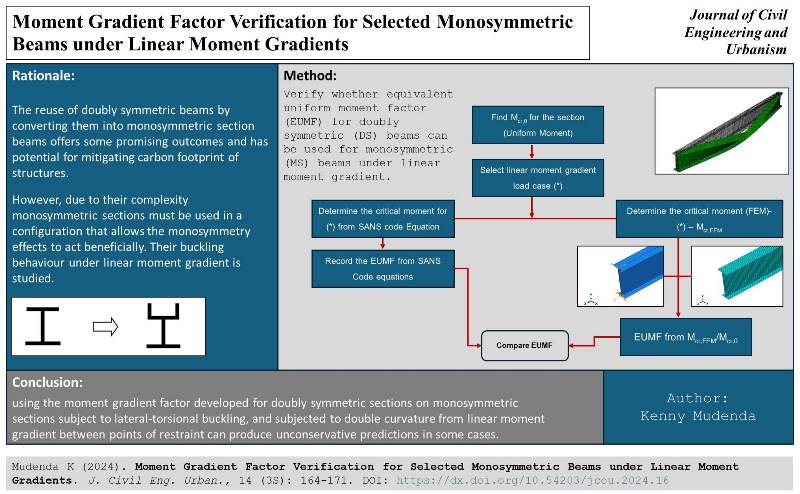 DOI: https://dx.doi.org/10.54203/jceu.2024.16
DOI: https://dx.doi.org/10.54203/jceu.2024.16
Abstract
The reuse of doubly symmetric beams by converting them into monosymmetric section beams offers some promising outcomes and has potential for mitigating carbon footprint of structures. However, due to their complexity monosymmetric sections must be used in a configuration that allows the monosymmetry effects to act beneficially. Although the South African design standard for hot-rolled steel does not provide any guidance on the design of monosymmetric beams, the Southern African steel construction handbook provides a formula for determining the critical elastic buckling moment for monosymmetric beams. This guidance implies that the moment gradient factor used for doubly symmetric sections can be used on monosymmetric sections as well. The aim of the study was to verify the validity of this approach of extending the moment gradient factor used for doubly symmetric beams to monosymmetric beams for two specific types of monosymmetric sections. It was found that although this approach appears to be justified for monosymmetric members in single curvature bending it may produce unconservative values of the critical buckling load in double curvature bending between restraint points. The level of un-conservatism also varies for different spans of the same member. This makes it difficult to specify a single moment modification factor value for these cases. The sensitivity in terms of load reduction observed for double curvature bending case was different for the two members examined with this attributed to differences in how the shear centre moves relative to the centroid. It is recommended that the critical buckling load for monosymmetric sections be determined on a case specific basis for members in double curvature from linear moment gradients. Under single curvature bending the moment gradient factor for doubly symmetric members appears to give acceptable predictions of the critical load.
Keywords: Steel beam, Monosymmetric, Lateral-torsional buckling, Moment gradient factor
[Full text-PDF] [Crossref Metadata] [Export from ePrints]
|
|
Research Paper
Experiences Encountered while Using Construction Contracts during Project Delivery in Botswana
Ssegawa JK, Ntshwene K, and Kamaruddeen AM.
J. Civil Eng. Urban., 14(3s): 172-181, 2024; pii:S225204302400017-14
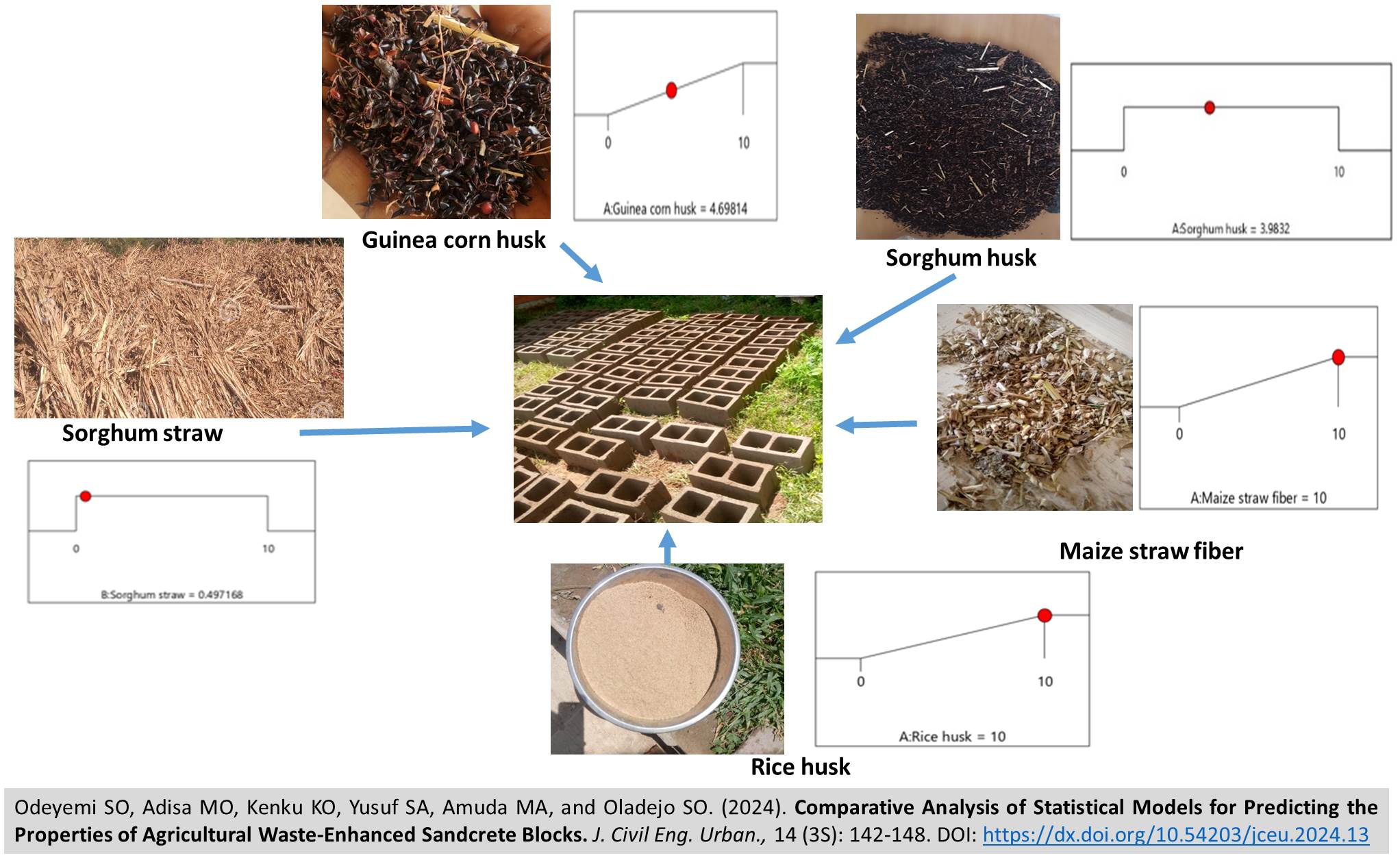 DOI: https://dx.doi.org/10.54203/jceu.2024.17
DOI: https://dx.doi.org/10.54203/jceu.2024.17
Abstract
Various forms of contracts guide the construction project delivery processes across the world. To make procurement more accessible and faster, various institutions have developed what is known as standard forms of contracts (SFoC). These institutions believe that SFoCs could be used in an adopted or adapted mode to reduce the burden of writing contracts every time a project is procured. This article discusses the results of a study that investigated the effectiveness of identified SFoCs and the experiences encountered by key stakeholders in using the contracts during construction project delivery. Study participants were drawn from contractor, consulting and client organisations and completed a questionnaire with both closed and open-ended questions. 11 attributes synthesised from literature were used to measure the effectiveness of a contract. Three major SFoCs were identified as being used in Botswana: the Joint Contract Tribunal (JCT), the New Engineering Contract (NEC) and International Federation of Consulting Engineers (FIDIC). The FIDIC has a long history of use, but in recent years, the NEC entered the arena. Due to the low usage of the JCT, the discussion centred on the NEC and FIDIC contracts. Some insights were drawn from the study. Respondents did not find a big difference in the effectiveness of the two contracts (WME for NEC =3.3 and FIDIC =3.1). However, there were a few attributes for which the NEC seemed to be a better contract. These were a) simple and non-legalistic language with self-contained clauses and b) a communicative and proactive risk management regime, which respondents identified with a propensity to reduce or avoid disputes. The study had the limitations of having used a small (38) sample of respondents and the fact that NEC has not been used in the country for the length of time as the FIDIC contract.
Keywords: Construction contract, Standard forms of contract, Contract Administration, Construction industry, Botswana
[Full text-PDF] [Crossref Metadata] [Export from ePrints]
|
|
Research Paper
Fixed-Bed Adsorption Dynamics of Total Organic Carbon from Gamodubu Landfill Leachate Using Biochar Derived From Gaborone Wastewater Treatment Plant Sewage Sludge
Tshenyego LD, Odirile PT and Gaboutloeloe GK.
J. Civil Eng. Urban., 14(3s): 182-189, 2024; pii:S225204302400018-14
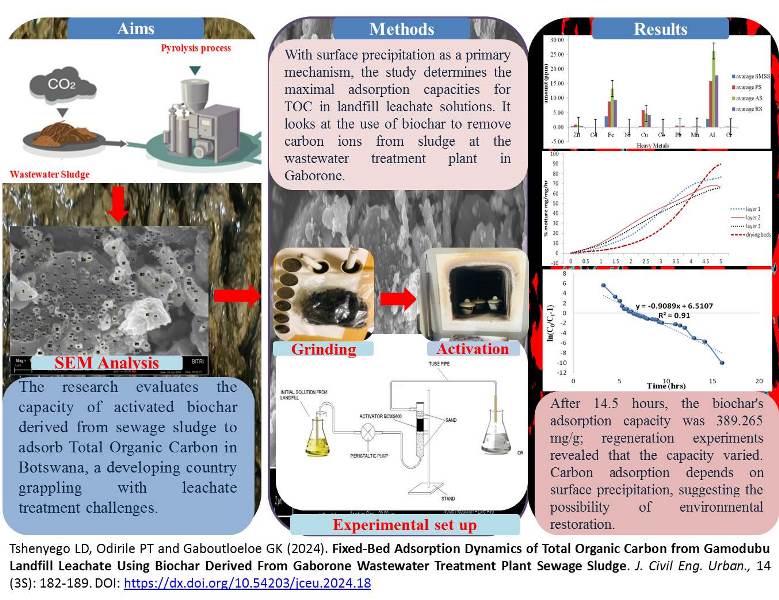 DOI: https://dx.doi.org/10.54203/jceu.2024.18
DOI: https://dx.doi.org/10.54203/jceu.2024.18
Abstract
In developing countries like Botswana, addressing leachate treatment presents considerable difficulties, especially regarding the management of sewage sludge (SS). This research evaluated the capacity of activated biochar, derived from sewage sludge, to adsorb Total Organic Carbon (TOC). Biochar was produced under conditions with limited oxygen, by placing approximately 50 grams of dried sewage sludge in sealed porcelain crucibles and heating them at a rate of 10°C per minute to 400°C for four hours. The resulting biochar (WWSBC400) was then stored in plastic bags in a dry environment. The pyrolysis yield was calculated as the ratio of the weight of the produced biochar to the initial weight of the dry sewage sludge. The study identified the maximum adsorption capacities (qm) for TOC in landfill leachate solutions, highlighting surface precipitation as a key adsorption mechanism for WWSBC400. Additionally, the removal of carbon ions using biochar produced from sludge at Gaborone's wastewater treatment facility was investigated. Continuous adsorption columns were utilized to demonstrate TOC solution adsorption, with performance evaluated in a fixed-bed column through model simulation. The Thomas model was used to compare experimental kinetic data, with the experimental data generally aligning well with the Thomas model, achieving a correlation coefficient (R²) of 0.9114 for the first round of activated biochar removal. The adsorption capacity of the biochar was recorded at 389.265 mg/g after 14.5 hours of column adsorption, with regeneration studies showing varying adsorption capacities of 742.82 mg/g, 875.47 mg/g, 682.13 mg/g, and 735.21 mg/g for successive rounds. Surface precipitation was found to be a vital process for carbon adsorption onto WWSBC400. In conclusion, using sewage sludge biochar for co-contaminated soil shows potential for heavy metal immobilization, presenting a viable option for environmental rehabilitation.
Keywords: Biochar Adsorption kinetic models; Fixed-bed column, Total Organic Carbon, sewage sludge, environmental remediation.
[Full text-PDF] [Crossref Metadata] [Export from ePrints]
|
|
Research Paper
Designing Ergonomic Safety Boots for Sustainable Construction in Botswana: A Case Study of Worker Foot Health
Botshabelo K, Sealetsa O, Setlhatlhanyo K. Moalosi R, Rapitsenyane Y, and Dichabeng P.
J. Civil Eng. Urban., 14(3s): 191-198, 2024; pii:S225204302400019-14
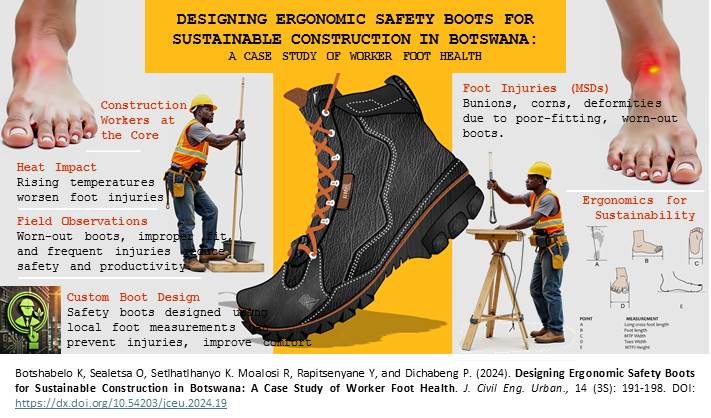 DOI: https://dx.doi.org/10.54203/jceu.2024.19
DOI: https://dx.doi.org/10.54203/jceu.2024.19
Abstract
The most essential asset in every construction work is the workers. In this regard, sustainability in construction must include and be centred on this vital resource. However, research indicates that civil engineers and construction workers often advocate for sustainability in infrastructural developments. This critical asset in construction often needs more consideration when people are engaged in construction work despite the many ergonomics challenges widely reported in the industry. This leads to workers in this industry being grossly afflicted by injuries such as musculoskeletal disorders, particularly of the foot. In addition, changes in global temperatures, attributed to global warming, situate civil engineers and construction workers, as they often work in open and challenging terrains, at risk of heat-related illnesses such as heat hyperpyrexia and heat exhaustion, which may also aggravate these musculoskeletal disorders conditions. However, it is pretty disturbing to notice that such illnesses are less investigated, particularly musculoskeletal disorders of the feet, which may be exasperated by the dire heat conditions noticeable in Botswana. This is because there is often a need for more knowledge and understanding of the risks associated with musculoskeletal disorders (MSDs). Furthermore, expertise in ergonomics is limited to assisting in the design of work as well as its conditions. This bequeaths both civil engineers and construction workers to operate under very challenging conditions despite pursuance of sustainability. Therefore, this case study investigated the prevalence of musculoskeletal disorders of the feet in the construction industry in Botswana with the purpose of designing a safety boot that matches the anthropometric measurements of the construction workers' feet. The research culminates in the design of a safety boot that is based on the workers' anthropometric measurements to prevent the occurrence of MSDs. The results of the study indicate that workers in this industry suffer from toe bunions, cons, toe deformities, smelly feet, etc. The study additionally indicates foot size differences across Botswana’s tribes. These differences may have severe implications for the use of safety boots and the development of ergonomics illnesses, mainly since the current safety boots used are imported from elsewhere with no modification to address the anthropometric feet measurements of Batswana. It is anticipated that the research will provide the necessary awareness that can help civil engineers explore sustainability not only from the context of infrastructural development (objects) but also from the perspective of workers (humans). This underscores the need for further research and action in this critical area.
Keywords: Construction Worker Ergonomics, Musculoskeletal Disorders, Safety Boot Design, Anthropometric Measurements, Heat-related Illnesses, Sustainable Construction Practices
[Full text-PDF] [Crossref Metadata] [Export from ePrints]
|
|
Research Paper
Effects of Resampled DEM on Watershed Characteristics and Prediction of Sediment Load in Oyun Watershed, Kwara, Nigeria
Adeogun AG, Mansur AW and Mohammed AA.
J. Civil Eng. Urban., 14(3s): 199-205, 2024; pii:S225204302400020-14
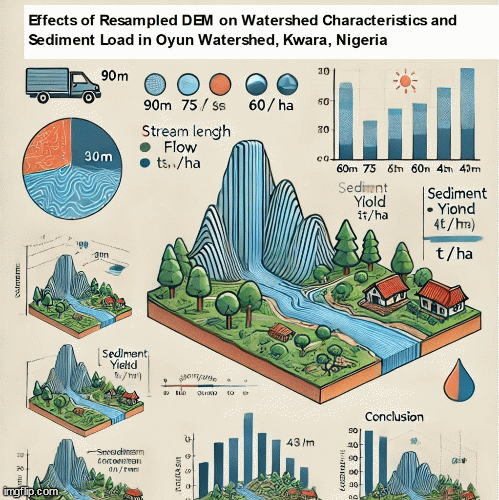 DOI: https://dx.doi.org/10.54203/jceu.2024.20
DOI: https://dx.doi.org/10.54203/jceu.2024.20
Abstract
Understanding the terrain and its impact on watershed characteristics, streamflow, and sediment loading is crucial for effective water resource management. This study investigates the influence of resampled Digital Elevation Models (DEM) on the prediction of watershed characteristics, streamflow, and sediment loading upstream of Oyun River Watershed, Nigeria. Various DEM resolutions, ranging from 30-meter to 90-meter, were analysed to assess their effects on hydrological predictions. To delineate the watershed, a DEM of 90-meter resolution was sourced from the space Shuttle Radar Topography Mission (SRTM), and the ASTER global DEM data sources. The 90-meter resolution was resampled to four different resolutions which are 75-meter, 60-meter, 45-meter, and 30-meter resolutions. The watershed and streamline were delineated, and the hydrologic simulation was performed using Soil and Water Assessment Tool (SWAT). The research findings revealed that changes in DEM resolution had a negligible impact on streamflow predictions within the Oyun River Watershed. However, a noticeable impact was observed in the prediction of sediment concentration. The 90-meter resolution DEM yielded the lowest predicted sediment concentration, measuring 2.28 mg/l, while the 30-meter resampled DEM produced the highest value at 5.21mg/l. Similarly, the sediment yield (SYLD t/ha) exhibited considerable variation across the different DEM resolutions, with the 90-meter DEM demonstrating the lowest value of approximately 528.90 t/ha, and the 30-meter DEM registering the highest at 2145.57 t/ha. Overall, this research highlights the necessity of careful DEM selection in hydrological modelling to ensure a comprehensive understanding of watershed dynamics, particularly in regions where sediment transport and water quality are of paramount concern.
Keywords: DEM, Hydrological Modelling, Nigeria, Sediment Loads, Watershed
[Full text-PDF] [Crossref Metadata] [Export from ePrints]
|
|
Research Paper
Stakeholders Influence on Construction Project Success
Mwakamui HK, Ntshwene K.
J. Civil Eng. Urban., 14(3s): 206-211, 2024; pii:S225204302400021-14
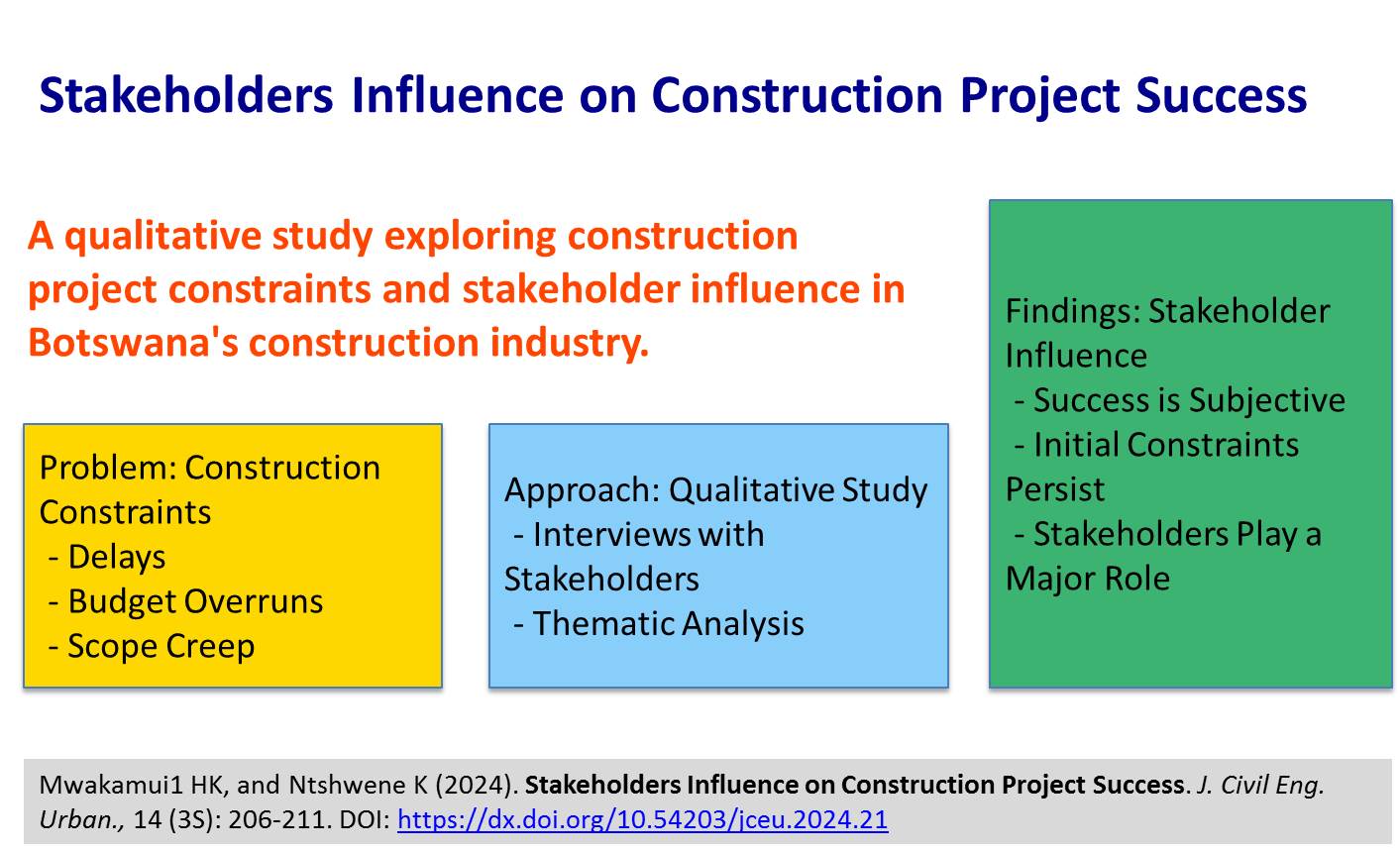 DOI: https://dx.doi.org/10.54203/jceu.2024.21
DOI: https://dx.doi.org/10.54203/jceu.2024.21
Abstract
For the past decade Botswana’s construction industry has been embroiled in a lot of controversies based on construction project constraints. These are characterized by construction project delays, budget overruns as well as scope creep and some of these construction projects have been deemed unsuccessful by different stakeholders. To find a mitigating factor for these problems, construction project constraints must be investigated beyond just the triple constraints to provide a solution for the Botswana construction industry. Therefore, the overall purpose of this study was to investigate how construction project constraints and stakeholders influence the outcome of a project. The study adopted a qualitative approach through face-to-face interviews with selected stakeholders such construction professionals, clients and other beneficiaries in the Gaborone and greater Gaborone areas. Thematic analysis was used to analyze data. The findings of the study established that the success of a construction project is subjective and is based on who is being asked, the construction professionals, the client and other beneficiaries had different perspectives on success of a project. The study revealed that initial constraints in a construction project tend to be carried along to the final stages of a construction project. However new few construction project constraints also emerge at the final stages of a construction project. The study found that stakeholders such as the client and other beneficiaries have a significant impact on construction projects due to their influence both positive and negative depending on the level of engagement.
Keywords: Factors of project success, Project constraints, Stakeholders, Triple constraints
[Full text-PDF] [Crossref Metadata] [Export from ePrints]
|
|
Research Paper
Integrating Prophet Forecasting with Gaussian Mixture Model- Hidden Markov Model (GMM-HMM) for Early Warning System in Dam Deformation Monitoring
Tshireletso T, and Moyo P.
J. Civil Eng. Urban., 14(3s): 212-219, 2024; pii:S225204302400022-14
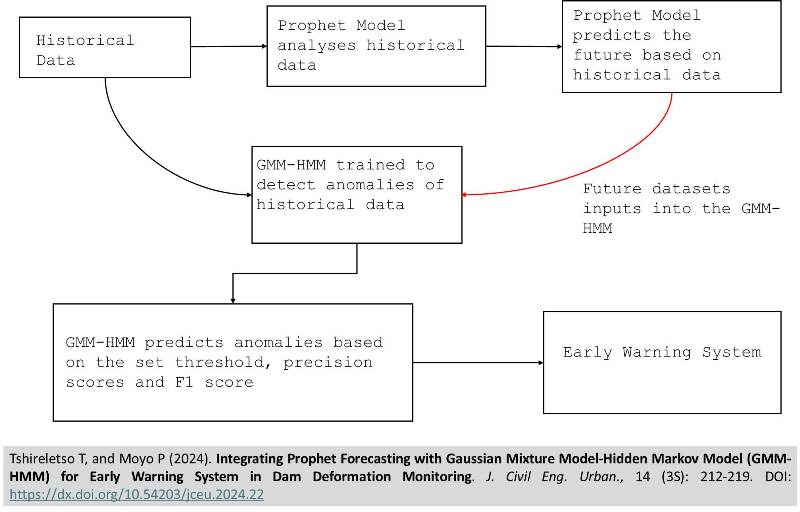 DOI: https://dx.doi.org/10.54203/jceu.2024.22
DOI: https://dx.doi.org/10.54203/jceu.2024.22
Abstract
Ensuring dam safety requires a monitoring system that can predict deformations and detect anomalies in real-time. This study combines the forecasting capabilities of the Prophet model with the real-time anomaly detection of a Gaussian Mixture Model-Hidden Markov Model (GMM-HMM) framework. The Prophet model analyses historical deformation data to forecast future deformations, enabling early issue identification. The GMM-HMM framework continuously monitors incoming data to detect deviations from predictions. Results shows that the GMM-HMM, with 10 components and a Mahalanobis distance threshold of 0.1, achieved a precision of 0.602, recall of 1.0, and F-1 score of 0.751, ensuring high sensitivity and accurate anomaly detection on. The GMM-HMM was then used to detect anomalies on Prophet forecasted radial deformations. Anomalies were detected on upper limit and lower limit deformations. This combined approach enhances dam safety by integrating predictive and real-time monitoring capabilities, offering a comprehensive early warning system for dam infrastructure.
Keywords: Gaussian Mixture Model, Hidden Markov Model, Prophet Model, Dam Deformation Forecasting
[Full text-PDF] [Crossref Metadata] [Export from ePrints]
|
|
Review
Navigating Climate Change: A Review of Policies in Botswana, Africa, and Beyond
Makoba M, Chaba TL, and Ramontsho QJ.
J. Civil Eng. Urban., 14(3s): 220-228, 2024; pii:S225204302400023-14
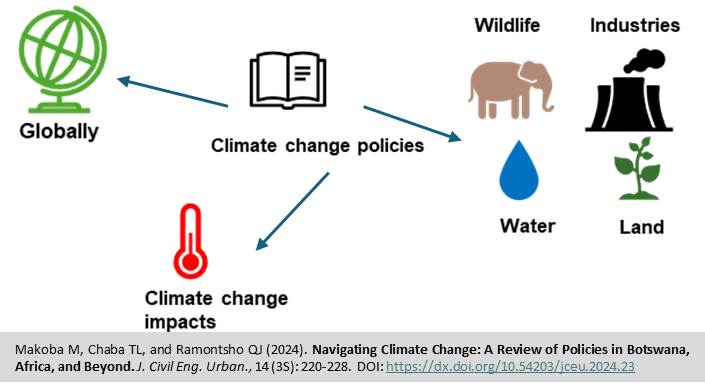 DOI: https://dx.doi.org/10.54203/jceu.2024.23
DOI: https://dx.doi.org/10.54203/jceu.2024.23
Abstract
This paper is an insightful perspective analysis of Botswana climate change policies in an effort to establish their effectiveness in relation to regional and international initiatives. For a critical review of both mitigation and adaptation efforts by different countries, the effectiveness is analysed, including their strengths and inadequacies noted, and recommendations made towards enhancing policy coherence and effectiveness. It examines the steps Botswana and other countries have taken to cut greenhouse gas emissions, improve energy efficiency, support the use of renewable energy sources, and implement sustainable land management practices. The paper also delves into Botswana's efforts to build climate resilience, such as creating a National Adaptation Plan and incorporating climate considerations across various sectors.
Keywords: Climate change policies, Policy review, International agreements, Sustainable development, Botswana
[Full text-PDF] [Crossref Metadata] [Export from ePrints]
|
|
Research Paper
Flexible Vegetation Behavior under Varying Areal Densities and Effects on Flow Structures: Numerical Observations
Busari AO and John KA.
J. Civil Eng. Urban., 14(3s): 229-237, 2024; pii:S225204302400024-14
DOI: https://dx.doi.org/10.54203/jceu.2024.24
Abstract
This study carried out extensive numerical studies on a refined “One dimensional (1-D) Reynolds Averaging Navier-Stokes (RANS) Model” for vegetated open channel flow. In the 1-D RANS model, the Spalart Allmaras closure model was used to model the turbulence caused by eddies within the vegetation zone and the interface between the top of the vegetation and the clear water zone. In this work, numerical simulations using 1-D RANS model are carried out using dataset obtained from the laboratory under different hydraulic conditions of varying areal vegetation densities. Three classes of highly flexible vegetation densities were simulated: low, medium and highly dense vegetation. The model predictions in terms of mean vertical stream-wise velocity profile and Reynolds Shear Stresses were compared with the laboratory flume experimental results. The 1-D RANS model performances were satisfactory for low and medium densities. However, discrepancies were seen in the model prediction for highly dense vegetation. Hence, the hydraulic roughness parameters in the numerical model has been modified for model re-calibration to capture the position of zero-displacement of velocities. Using the modified parameters, the velocity profiles and the Reynolds Shear Stresses were predicted with very low uncertainty.
Keywords: Zero-displacement parameter, 1-D RANS model, Reynolds shear stresses, areal density, flexible vegetation
[Full text-PDF] [Crossref Metadata] [Export from ePrints]
|
|
Research Paper
Performance-Based Evaluation of Steel Fibre Reinforced Normal- and High-Strength Concretes Using Statistical Analysis of Experimental Database
Adewuyi AP, and Animbom O.
J. Civil Eng. Urban., 14(3s): 238-246, 2024; pii:S225204302400025-14
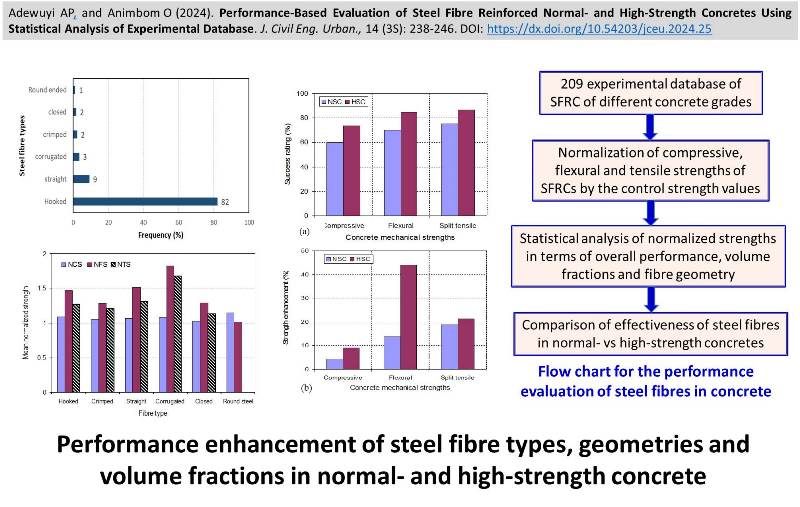 DOI: https://dx.doi.org/10.54203/jceu.2024.25
DOI: https://dx.doi.org/10.54203/jceu.2024.25
Abstract
The widespread acceptance of concrete can be attributed to its unique characteristics, despite inherent drawbacks such as brittleness and weak tensile strength. The study was aimed at evaluating the optimal content and characterization of steel fibres required to impede crack propagation and enhance overall strength of concrete. The influence of critical factors like fibre content, length, diameter, and volume fraction on the performance of steel fibre reinforced concretes (SFRC) through statistical analysis of 209 experimental data. The influence of these factors on the compressive, flexural, and tensile strengths of concrete was analyzed as a function of the mean and coefficient of variation of the normalized strength values. The study found that steel fibres in concrete produced success rates of 67.9% (7.1% average strength improvement = ASI) in compressive strength, 78.5% (38.2% ASI) in flexural strength and 84.2% (23.8% ASI) in tensile strength. The study further separately examined the impact of steel fibres on both normal strength concretes (NSC) and high strength concretes (HSC). The findings indicated an overall success rate of 60% (6.97% ASI), 69.9% (38.36% ASI), and 75.6% (23.59% ASI) for compressive, flexural, and split tensile strength, respectively, in NSC. However, higher degree of strength enhancement of 74.0% (7.16% ASI), 84.8% (39.21% ASI), and 86.6% (23.51% ASI) were recorded for compressive, flexural, and split tensile strength, respectively in HSC. The research underscores the effectiveness of incorporating steel fibres as a reinforcement strategy in enhancing various strength aspects of concrete.
Keywords: Fibre reinforced concrete, steel fibres, compressive strength, tensile strength, flexural strength, normalized strength, average strength improvement.
[Full text-PDF] [Crossref Metadata] [Export from ePrints]
|
|
Research Paper
Empirical Scrutiny of Geopolymer Concrete Containing Locally-produced Superplasticizer under Varied Temperatures
Agashua LO, Arum C, Oluyemi-Ayibiowu BD, and Ikumapayi CM.
J. Civil Eng. Urban., 14(3s): 247-262, 2024; pii:S225204302400026-14
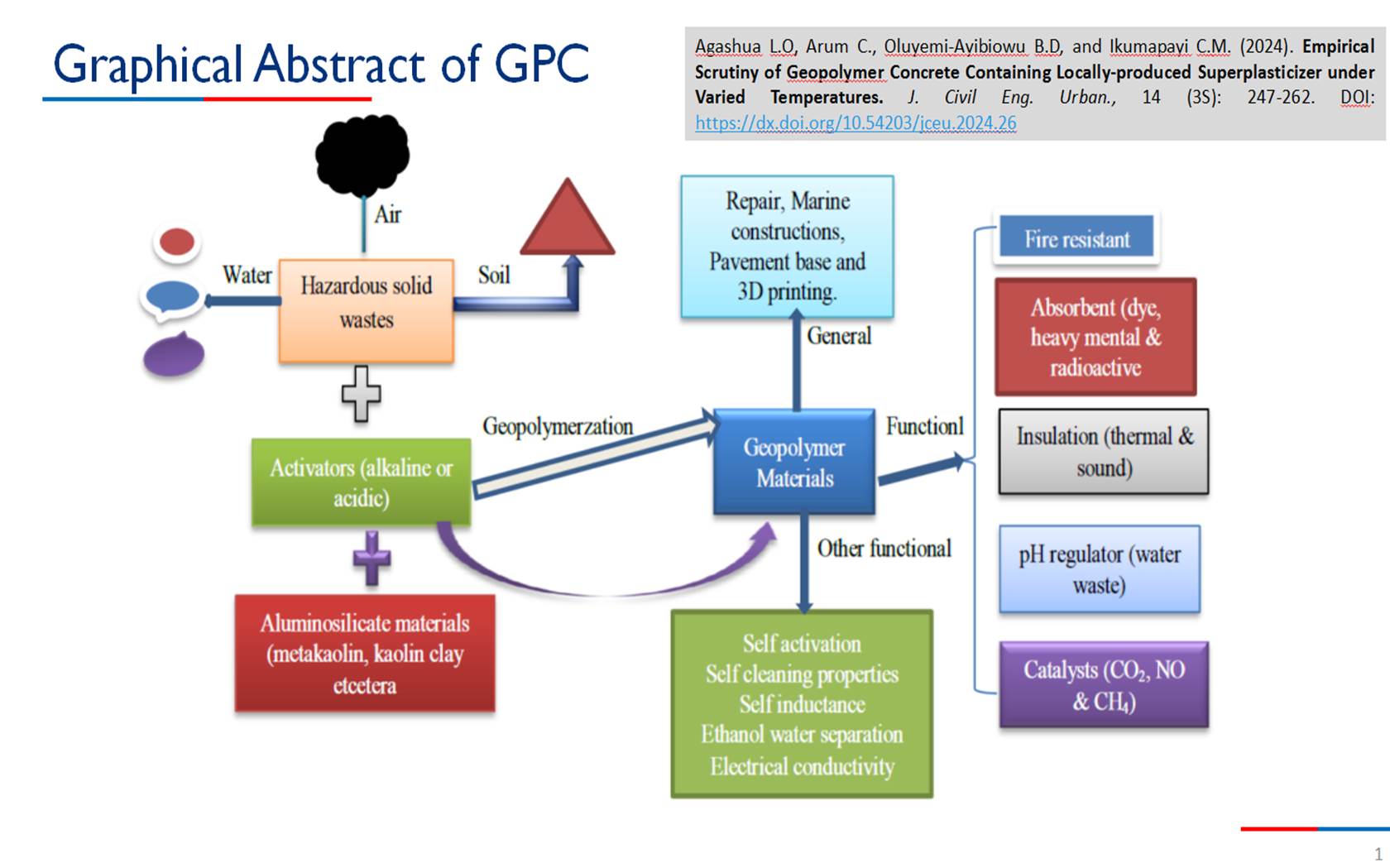 DOI: https://dx.doi.org/10.54203/jceu.2024.26
DOI: https://dx.doi.org/10.54203/jceu.2024.26
Abstract
Cement manufacturing companies contribute greatly to carbon-dioxide emission during production, hence there is need for novel eco-friendly or biodegradable cementitious material, which has the same strength and also durable. Geopolymers which are eco-friendly waste materials, which can also reduce construction cost are therefore considered for this purpose. The geopolymer stabilizing materials, fly ash (FA), kaolin clays powder (KCP), rice husk ash (RHA), and alkaline activator (procured sodium silicate, waste-created sodium silicate and sodium hydroxide) were added at 0, 2.5, 5, 7.5, and 10%, to the naturally created superplasticizer geopolymer concrete (GPC), so as to solve the problem of workability and efflorescence associated with fly ash based GPC. FTIR results shows major absorbance band at the region between 950 and 3250 cm−1. It means that addition of the naturally made superplasticizer to the geopolymer concrete lowered the viscosity and increased the flow behavior of concrete. The geopolymer concrete consists of super plasticizer (1.5%) and optimum of various binders i.e. 5% FA + 7.5% KC + 10% RHA + aggregate + water. At temperature above 70°C both compressive strength and weight decreases, for naturally made and purchased sodium silicate. The optimal geopolymer product showed substantial strength and durability enhancements at 70°C temperatures, with strength and durability values decline above 70°C, indicating material deterioration. A positive correlation between hot-state temperature, strength and durability properties was also established. The R2 of the Feret on the test set reaches 0.967, indicating its excellent predictive performance.
Keywords: Rice Husk, Fourier Transform Infrared Spectroscopy, Waste-created sodium silicate, Superplasticizer; Eco-friendly
[Full text-PDF] [Crossref Metadata] [Export from ePrints]
|
|
Research Paper
An Analysis of Water Demand of the Rural Population within the Iishana System, Namibia
Eino J, Katte VY, Busari AO, Pires EES, Johannes P, Fahrenberg M, Reinhardt CI, Jüpner R and Schulte A.
J. Civil Eng. Urban., 14(3s): 263-270, 2024; pii:S225204302400027-14
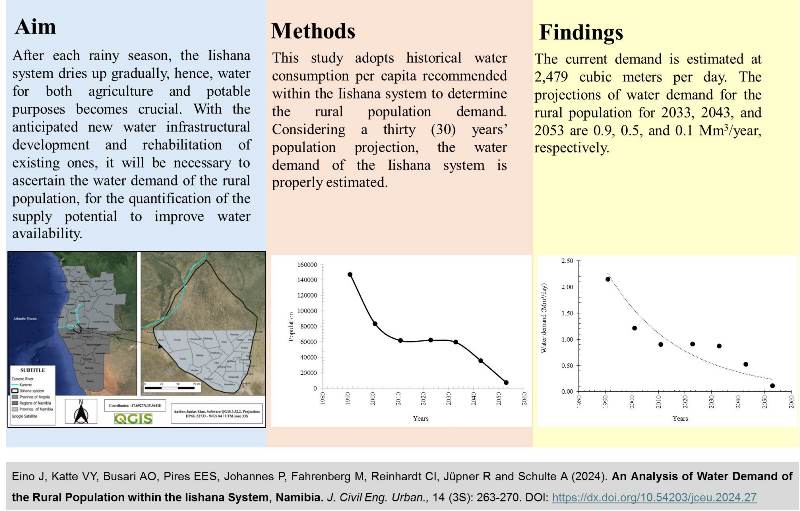 DOI: https://dx.doi.org/10.54203/jceu.2024.27
DOI: https://dx.doi.org/10.54203/jceu.2024.27
Abstract
The Namibian people, particularly, those living within the Iishana system, which is a subset of the Cuvelai Basin, often encounter recurrent floods and droughts. After each rainy season, the Iishana system dries up gradually, hence, water for both agriculture and potable purposes becomes crucial. With the anticipated new water infrastructural development and rehabilitation of existing ones, it will be necessary to ascertain the water demand of the rural population, for the quantification of the supply potential to improve water availability. This study adopts historical water consumption per capita recommended within the Iishana system to determine the rural population demand. Considering a thirty years’ population projection, the water demand of the Iishana system is properly estimated. Moreover, the historical hydrological dataset daily data for the period 2012-2021 was used for the analysis. The current demand is estimated at 2,479 cubic meters per day. The projections of water demand for the rural population for 2033, 2043, and 2053 are 0.9, 0.5, and 0.1 Mm3/year, respectively. More so, the surface water resource potential of the system is estimated at an average of 300 mm/year. The region loses more water through evaporation than it receives in the wet season. Around 2500 mm of water evaporates from the surface annually, giving a water deficit of 2200 mm/year. The region's flat, shallow landscape, high evaporation rate, and the inadequacy of infrastructure have made the area vulnerable in terms of water security for both agricultural and potable purposes, resulting in droughts after the rainy season. With these findings, it is recommended to build water infrastructures within the region to improve the well-being and livelihood of rural communities.
Keywords: Water demand, water supply, rural population, per capita demand, Iishana system, Namibia
[Full text-PDF] [Crossref Metadata] [Export from ePrints]
|
|
Research Paper
Meeting the Sustainability Emergency in Built Environment Curricula through Tripartite Pedagogy Quasi-Experimentation
Ewurum NI, Aguome NM, Kelobonye K, Emoh FI.
J. Civil Eng. Urban., 14(3s): 271-277, 2024; pii:S225204302400028-14
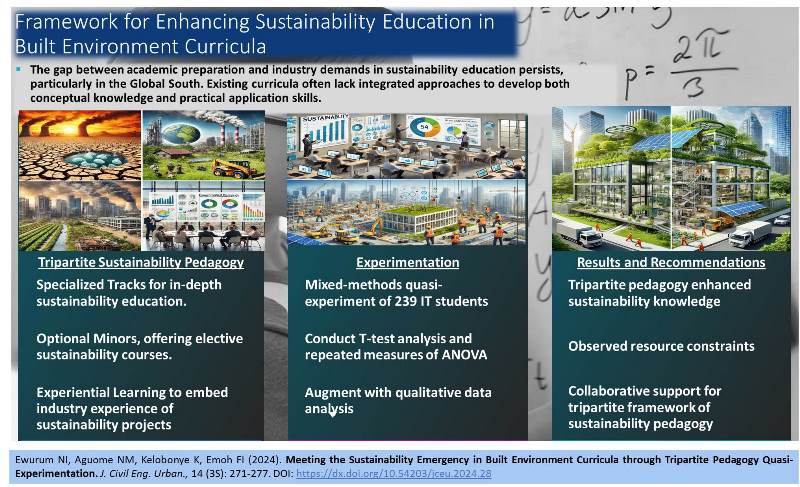 DOI: https://dx.doi.org/10.54203/jceu.2024.28
DOI: https://dx.doi.org/10.54203/jceu.2024.28
Abstract
This study evaluates the effectiveness of a tripartite pedagogy framework integrating specialized tracks, optional minors, and experiential learning to enhance sustainability education in built environment curricula. Employing a mixed-methods quasi-experimental design, the research assessed 239 industrial training students in Enugu, Nigeria. Results from the t-test demonstrate significant improvements in sustainability knowledge post-intervention and high interest in optional sustainability courses. Repeated measures of ANOVA revealed substantial enhancements in students' ability to apply sustainability concepts over time. Qualitative data highlighted practical challenges in experiential learning, including resource constraints. The findings provide empirical support for the tripartite approach, extending previous research by quantifying impacts on practical skills development. This study contributes to the limited body of evidence on integrated sustainability education interventions in the Global South, demonstrating significant improvements in students' sustainability knowledge and application skills through a tripartite pedagogy framework. The findings highlight the potential of specialized tracks, optional minors, and experiential learning to bridge the gap between academic preparation and industry needs. It is recommended that educational institutions prioritize these integrative approaches and address resource constraints to enhance the effectiveness and scalability of sustainability education in built environment curricula.
Keywords: Building Research Establishment Environmental Assessment Methodology, Built environment curricula, Experiential learning, Optional minors, Specialized tracks, Sustainability competencies
[Full text-PDF] [Crossref Metadata] [Export from ePrints]
|
|
Research Paper
Enhancing Water Level Prediction through a Hybrid Feature Selection Approach
Tshireletso T, Ouma Y, Moalafhi D, and Anderson G.
J. Civil Eng. Urban., 14(3s): 278-282, 2024; pii:S225204302400029-14
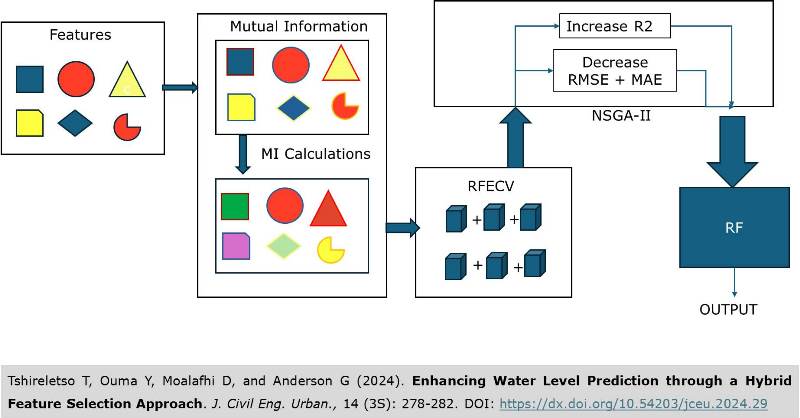 DOI: https://dx.doi.org/10.54203/jceu.2024.29
DOI: https://dx.doi.org/10.54203/jceu.2024.29
Abstract
Accurate prediction of water levels (WL) is essential for various applications, from flood management to environmental monitoring. In this study, an enhanced approach to feature selection tailored for water level prediction models is presented. Our method integrates Mutual Information and Recursive Feature Elimination with Cross-Validation (RFECV), augmented by the Non-Dominated Sorting Genetic Algorithm II (NSGA-II), to systematically evaluate and refine subsets of features. Mutual Information facilitates the identification of relevant feature dependencies, while RFECV iteratively eliminates less informative features to optimize predictive accuracy. The inclusion of NSGA-II further enhances the selection process by considering multiple conflicting objectives simultaneously, such as maximizing R2 score and minimizing the number of selected features, RMSE, and MAE. Through extensive experimentation and validation on real-world datasets, we demonstrate the effectiveness of our hybrid feature selection approach in capturing intricate relationships within the data, leading to significantly improved predictive performance in water level prediction models.
Keywords: Mutual Information, Recursive Feature Elimination with Cross validation, Non-Dominated Sorting Genetic Algorithm II
[Full text-PDF] [Crossref Metadata] [Export from ePrints]
|
|
Research Paper
Investigation of Performance of Copper Slag and Ore Tailings Novel Trial Self-compacting Concrete Mixtures
Fidler A and. Oyejobi DO.
J. Civil Eng. Urban., 14(3s): 283-288, 2024; pii:S225204302400030-14
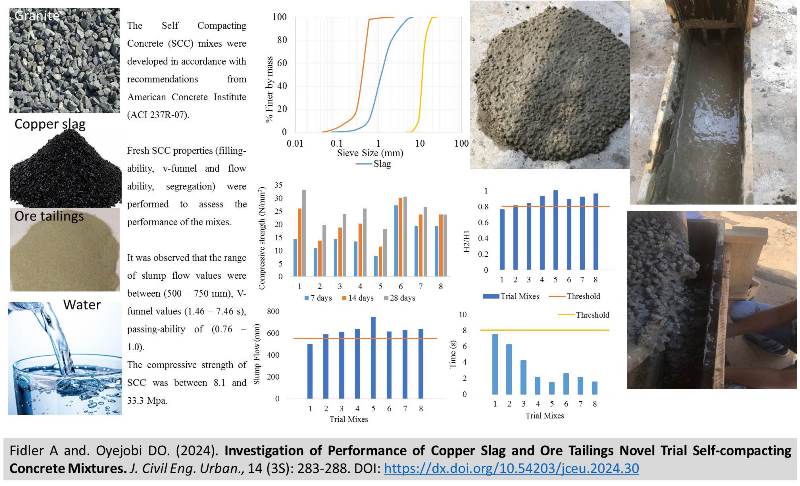 DOI: https://dx.doi.org/10.54203/jceu.2024.30
DOI: https://dx.doi.org/10.54203/jceu.2024.30
Abstract
A non-conventional concrete with the properties of flow-ability, filling-ability, and passing-ability without any need for mechanical compaction but flow under self-weight is known as self-compacting concrete. This study developed trial mixtures for self-compacting concrete (SCC) using locally available waste products. The copper slag and ore tailings from Bamangwato Concessions Limited Mine in Selebi-Phikwe, Botswana were used as source of fine aggregate, and fines substitute. Eight mix proportions were developed with the quantities of cement, granite, copper slag, ore tailings and water-cement ratio as variables. The mix proportions were developed in accordance with recommendations from American Concrete Institute (ACI 237R-07) and fresh SCC properties (flow ability, passing ability, filling-ability, and segregation) were performed to assess the performance of the mixes. It was observed that the range of slump flow values were between (500 – 750 mm), V-funnel values (1.46 – 7.46 s), passing-ability of (0.76 – 1.0). The hardened properties of SCC (strength and density) were between 8.1 and 33.3 MPa, and 2093 to 2406 kg/m3) respectively. It could be concluded that SCC produced from mine wastes (copper slag and ore tailings) is found suitable for the use in unreinforced and normal concrete applications.
Keywords: Self-compacting concrete, filling-ability, flow-ability, passing-ability, slump flow, segregation and compressive strength.
[Full text-PDF] [Crossref Metadata] [Export from ePrints]
|
|
Research Paper
Efficacy of Direct SPT-Based Pile Design Methods in Residual Soils of Southern Africa
Masilo T and Dithinde M.
J. Civil Eng. Urban., 14(3s): 289-294, 2024; pii:S225204302400031-14
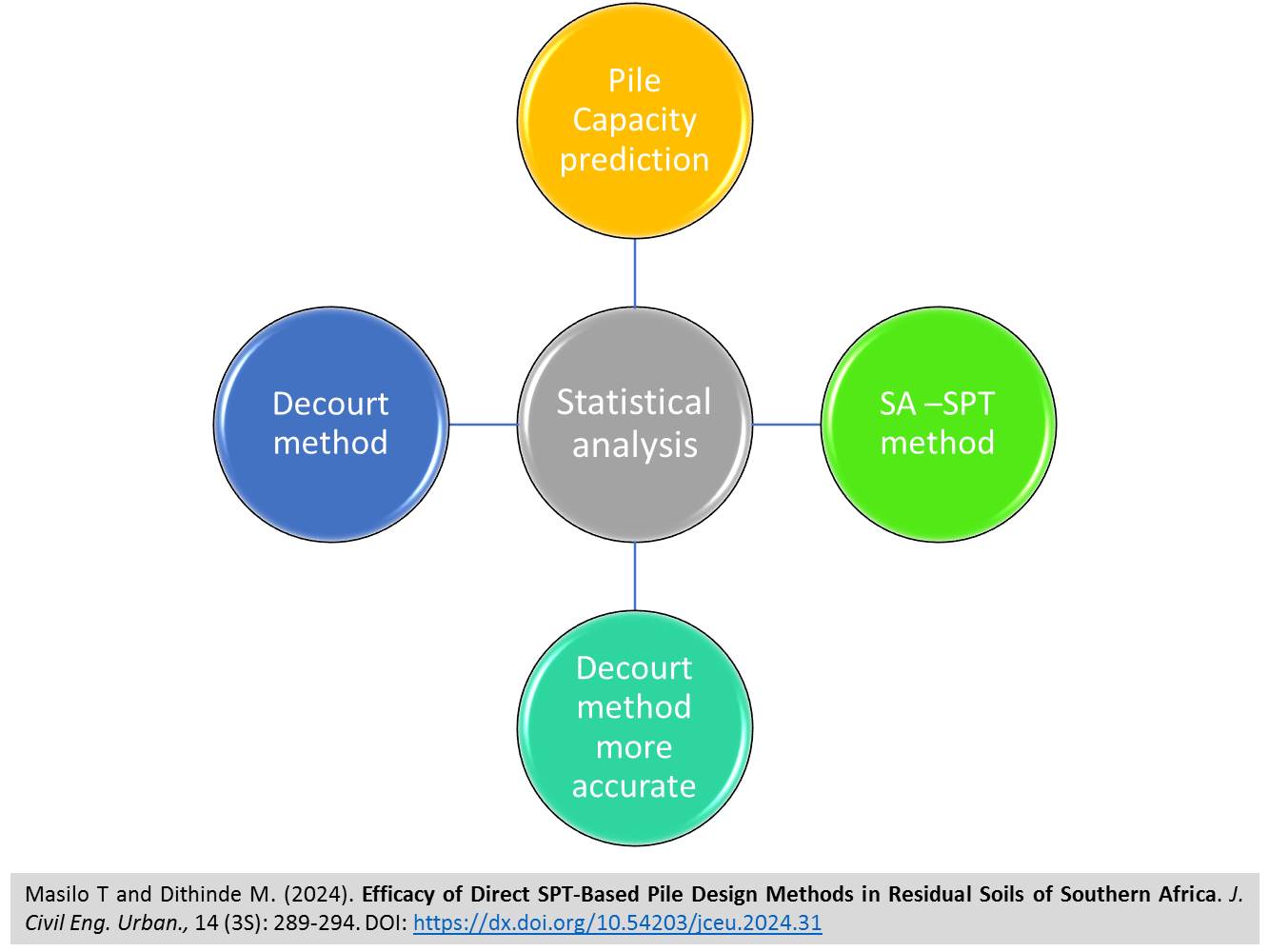 DOI: https://dx.doi.org/10.54203/jceu.2024.31
DOI: https://dx.doi.org/10.54203/jceu.2024.31
Abstract
Direct SPT-based pile design methods are very popular these days despite the fact that many of such methods are based on small databases of pile load tests. Due to the dependence of soil behaviour on geological setting and site specific conditions, it is possible that some of the methods do not produce good prediction of pile capacity. Accordingly this paper presents the evaluation of two SPT-based pile design methods in residual soils against a pile load test database from the Southern African region. The methods include the (i) Franki-SA method reported in Byrne et al. (1995) and (ii) Decourt Method (1995). The pile load tests consist of 26 cases of bored piles in residual soil with each case accompanied by SPT measurements. The SPT measurements were used to calculate the predicted capacity in accordance with the procedure for each of the two methods while the pile load tests were used to determine the measured capacity. The findings of the evaluation indicate that the Decourt method is more reliable and accurate than the SA method. The poor performance of the SA methods suggests further studies to develop specific calculation factors for base and shaft capacities in residual soils.
Keywords: SPT-based pile methods, Load Bearing Capacity, Pile Load Test, Chin extrapolation method, Terzhagi’s 10% criteria, Rank Index.
[Full text-PDF] [Crossref Metadata] [Export from ePrints]
|
|
Research Paper
Behaviour of Fly-Ash Geopolymer Mortar in Simulated Environments
Oyejobi DO.
J. Civil Eng. Urban., 14(3s): 295-301, 2024; pii:S225204302400032-14
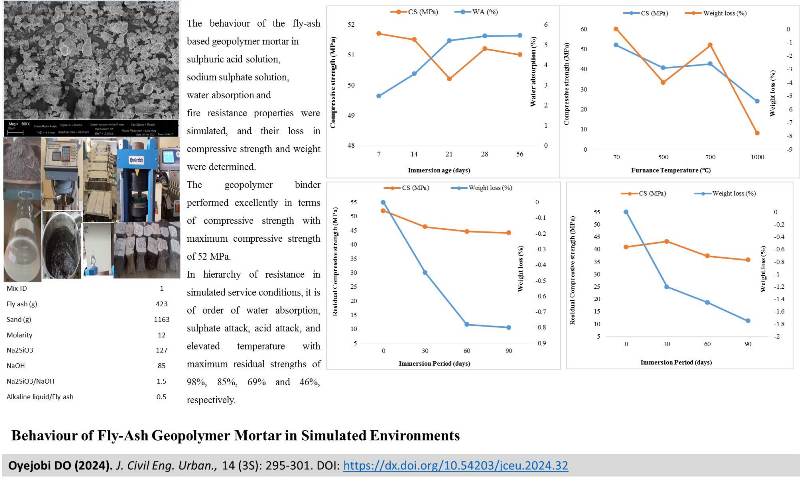 DOI: https://dx.doi.org/10.54203/jceu.2024.32
DOI: https://dx.doi.org/10.54203/jceu.2024.32
Abstract
Concrete and mortar usually found themselves in normal and harsh environments. The environment has great influence on the mechanical and durability behaviours of the concrete. In this study, fly ash was processed using circular economy concept and subsequently used as precursor for geopolymer mortar. The fly ash from Morupule power plant station has previously been characterized for its physical, chemical, and microstructural properties. Based on its suitability, the fresh and mechanical properties of the geopolymer mortar were carried out, and afterward, the durability behaviour is investigated in this study. The geopolymer mortar was formulated from the mixture of fly ash, sand and alkaline activators and cured thermally at 70°C. The behaviour of the geopolymer mortar in sulphuric acid solution, sodium sulphate solution, water absorption and fire resistance properties were simulated, and their loss in compressive strength and weight were determined. The laboratory experiment indicated that geopolymer mortars are highly resistant to sulphate attack, water absorption with moderate resistance against sulfuric acid and fire resistance. The effects of varying other parameters on the performance of concrete can be looked into in the future studies.
Keywords: Geopolymer mortar, environment, durability, mechanical, fly ash, circular economy
[Full text-PDF] [Crossref Metadata] [Export from ePrints]
|
|
Research Paper
Flexural Behaviour of Concrete Beams Reinforced With Major Steel Bars under Normal and Corrosive Operational Conditions
Adewuyi AP and Eric GB.
J. Civil Eng. Urban., 14(3s): 302-310, 2024; pii:S225204302400033-14
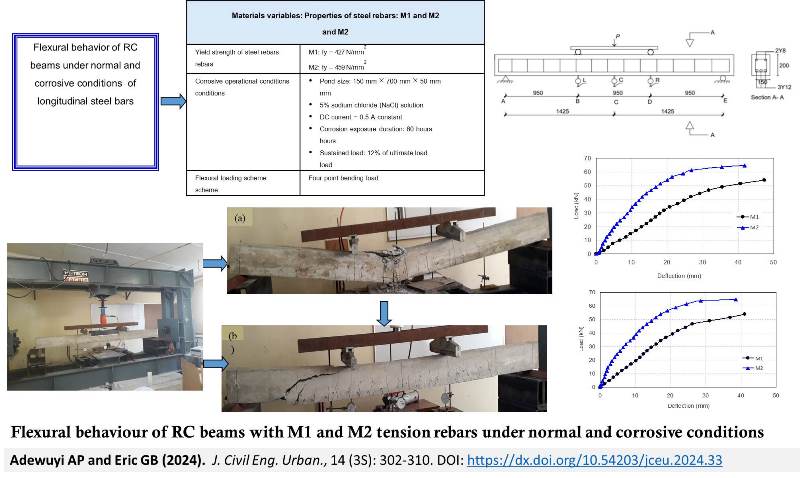 DOI: https://dx.doi.org/10.54203/jceu.2024.33
DOI: https://dx.doi.org/10.54203/jceu.2024.33
Abstract
Quality assurance of construction materials is very fundamental for structural safety, reliability, serviceability, and durability of constructed civil infrastructure. Inflow of defective or substandard building and construction materials into the industry, particularly reinforcing steel bars, is responsible for many structurally deficient constructed facilities which often lead to failure or ultimate collapse of reinforced concrete (RC) structures. Characterization of steel rebars from two major manufacturers into Botswana construction industry, designated herein as M1 and M2, were conducted as a basis for the evaluation of the quality assurance and control of the products. The flexural behaviour of their respective RC beams, designated herein as B-M1 and B-M2, of dimension 150 × 200 × 3000 mm and subject to four-point loading tests were determined under normal and artificially induced corrosion conditions to assess the influence of steel rebars M1 and M2 on the stiffness and load-carrying capacity. The average yield strengths of steel reinforcing bars were 427 N/mm2 for M1 and 459 N/mm2 for M2. The moduli of elasticity for M1 and M2 were 203 GPa and 205 GPa, respectively. The percentage elongation was found to be 7.93% for M1 and 7.24% for M2. The flexural strength of beams reinforced with M1 was 7% and 16.5% lower than RC beam with M2 under normal and accelerated corrosion of 5% of NaCl solution for 60 hours condition, respectively. The flexural behaviour of RC beams reinforced with B-M1 had a lower flexural strength under both normal and corrosive environmental conditions as compared to B-M2. The flexural strength of B-M1 had reduced from 48.5 N/mm2 to 41.0 N/mm2, while B-M2 reduced from 52.2 N/mm2 to 49.2 N/mm2. This represented loss of load-carrying capacity of 15.4% and 5.8% for B-M1 and B-M2 respectively due to exposure to corrosive environment. The findings revealed disparity in bending capacity due to the low interfacial bonding due to reduced relative rib areas. A more intensive quality control of imported steel should be ensured at the ports of entry by relevant regulatory agencies.
Keywords: Flexural capacity, Sfiffness, Reinforcing bars, Relative rib area, Interfacial bonding, Accelerated corrosion, Ultimate load.
[Full text-PDF] [Crossref Metadata] [Export from ePrints]
|
|
Research Paper
The Use of Machine Learning Approach to Predict Pile Capacity in Non-Cohesive Soils
Palalane L and Dithinde M.
J. Civil Eng. Urban., 14(3s): 311-317, 2024; pii:S225204302400034-14
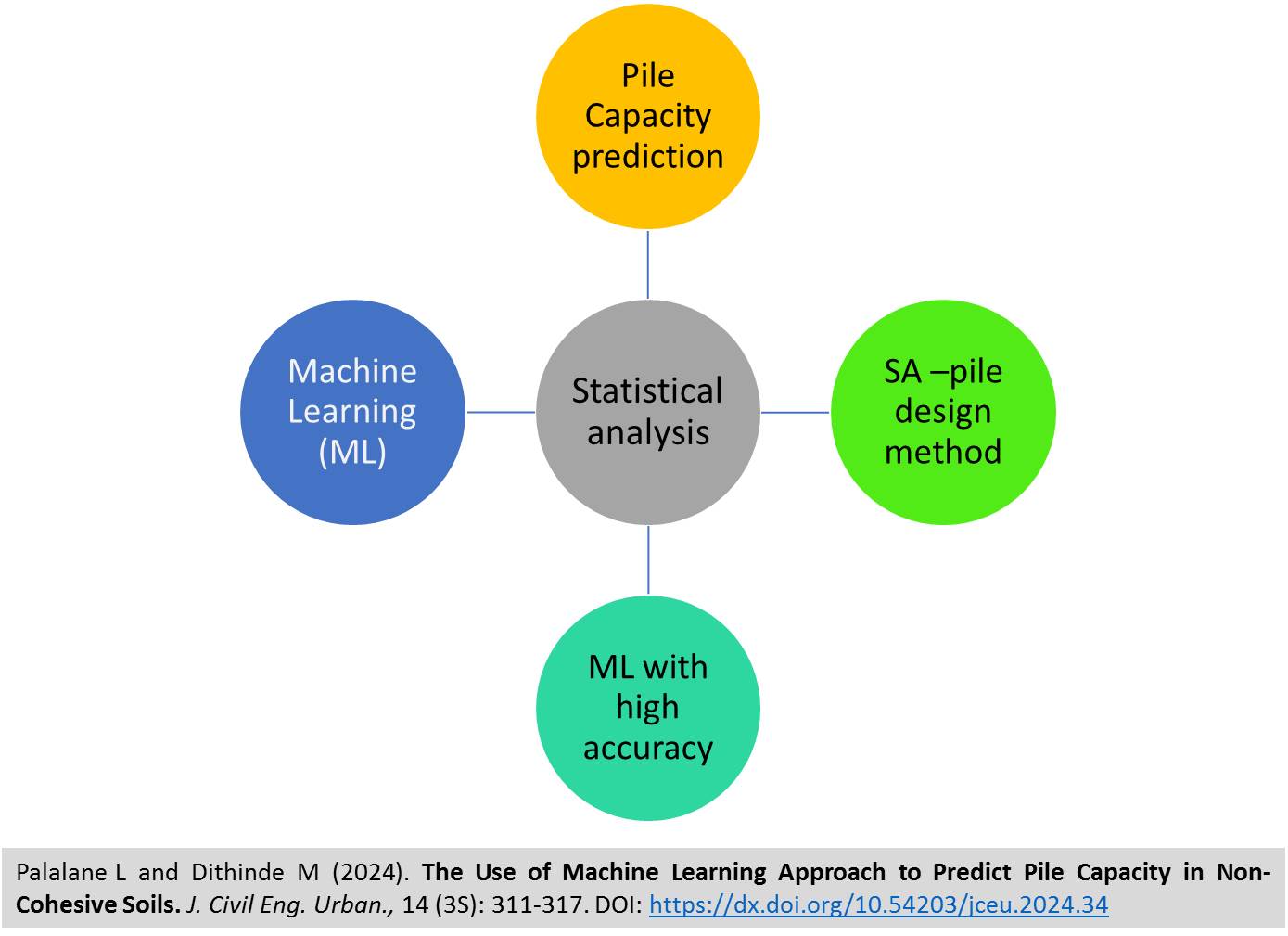 DOI: https://dx.doi.org/10.54203/jceu.2024.34
DOI: https://dx.doi.org/10.54203/jceu.2024.34
Abstract
Existing theoretical and empirical pile design methods cannot accurately model the complex interaction between piles and soil. Consequently, there is a growing trend towards utilizing machine learning techniques to better capture the nonlinear soil-pile interaction. This paper aims to predict the capacity of bored piles in cohesionless soils using a machine learning approach. The machine learning algorithm was trained using a database of 18 bored pile cases in non-cohesive soils and validated with a separate dataset of 8 bored piles in cohesionless soil. Moreover, the performance of the machine learning method was compared with that of a traditional pile design method (i.e., SA-SPT method) in Southern Africa. The evaluation was based on the ratio of measured capacity to predicted capacity (Qm/Qp) statistics and the coefficient of determination (R2). The results showed an R2 of 0.89 for the machine learning method compared to 0.85 for the SA-SPT method, indicating the superior accuracy of the machine learning approach in predicting pile capacity.
Keywords: Machine learning, SPT-based pile methods, Load Bearing Capacity, Full-scale Load Test, Chin extrapolation method, Terzhagi’s 10% criteria.
[Full text-PDF] [Crossref Metadata] [Export from ePrints]
|
|
Research Paper
Geotechnical characterization of the Manyana black cotton soils in Botswana
Marumo MN, Lebitsa G, Malumbela G.
J. Civil Eng. Urban., 14(3s): 318-324, 2024; pii:S225204302400035-14
DOI: https://dx.doi.org/10.54203/jceu.2024.35
Abstract
The Manyana Village is divided into two types of soils. The center of the village is covered with sand that overlays clays from weathered dolerite whilst the eastern side is covered with exposed clays. Houses constructed on the eastern side of the village are prone to severe cracking attributed to the black cotton soils. The paper hints at shrink-swell mechanism of black cotton soils as a possible explanation for the cracking observed on the houses. Three laboratory methods of identifying and characterizing expansive soils are discussed followed by use of Dynamic Cone Penetration (DCP) in field-testing as well as use of indicator tests and particle sizing in the laboratory. The experimental results have shown a high field moisture content of (18 to 27%) in the eastern part of the village which was three times larger than moisture content at the village center. The clays had a plasticity index range of 12% to 30% with a clay content of 21% to 47% whilst the sandy areas were non-plastic with a clay content of at most 4%. The clay minerals identified from the samples tested were vermiculite, illite, kaolinite and montmorillonite. The soil samples from the village had low potential expansiveness whilst most samples on black cotton soil had a medium to high potential of expansiveness. The bearing capacity estimated from DCP data at depths of 1m throughout the village were 72 kPa to 275 kPa under dry conditions. A draft plasticity index map of Manyana village was produced based on the results of the investigation, the next step is to investigate the effectiveness of different soil stabilization methods for this area and taking in to consideration cost, durability and environmental impact.
Keywords: Black cotton soil, Cracking, Moisture content, Plasticity index, Bearing capacity.
[Full text-PDF] [Crossref Metadata] [Export from ePrints]
|
|
Research Paper
Evaluation of the Compressive Strength and Sorptivity of Pozzolanic Concrete Containing Calcined Termite Mound
Ikumapayi CM, Arum C, Arum V, Omoyajowo MO, Omotayo OO, and Ohwofasa OJ.
J. Civil Eng. Urban., 14(3s): 325-333, 2024; pii:S225204302400036-14
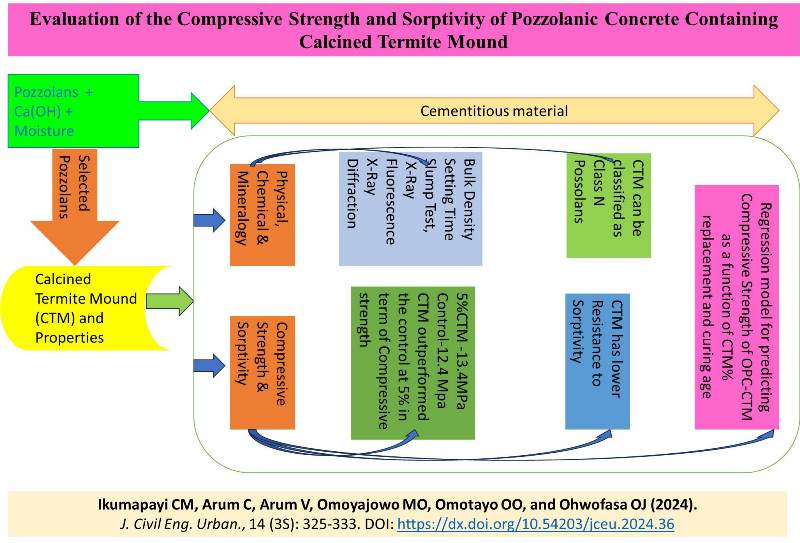 DOI: https://dx.doi.org/10.54203/jceu.2024.36
DOI: https://dx.doi.org/10.54203/jceu.2024.36
Abstract
Pozzolans have long been established as viable materials for the partial replacement of cement in concrete. However, the extent to which they can be used is still under investigation. Pozzolans do not in themselves have cementitious value but can react chemically with calcium hydroxide and moisture to produce cementitious compounds. Pozzolanic concretes have been reported to have varied properties in term of compressive strength and durability properties which need to be ascertained. This research focuses on Calcined Termite Mound (CTM) and its influence on the compressive strength and sorptivity of concrete. Several tests were carried out to ascertain the physical, chemical, and mineralogical properties of CTM and conventional concrete constituents. Some of these tests include bulk density, setting time, aggregate crushing value (ACV), aggregate impact value (AIV), slump test, X-Ray Fluorescence (XRF), X-Ray Diffraction (XRD), sorptivity, and compressive strength tests. Compressive strength tests results for concrete containing Ordinary Portland Cement (OPC) and CTM cement blends show that CTM has higher silica content compared to OPC and can be classified as Class-N pozzolans It is also richer in calcium oxide. The study also reveals that CTM has an optimum replacement level of 5% with strength of 13.4 MPa at 28 days, which is higher than the 12.4 MPa of control concrete. Also, the result of sorptivity test for OPC-CTM blended concrete gave lower resistance to sorptivity. Regression models were developed to predict the compressive strengths of OPC-CTM concrete as a function of % replacement level and curing age.
Keywords: Calcine termite mould; Compressive strength; Pozzolanic concrete; Sorptivity.
[Full text-PDF] [Crossref Metadata] [Export from ePrints]
|
|
Research Paper
Estimation of Water Demand for the Rural Population in the Angolan Part of the Iishana System
Chiweyengue AM, Serrão Pires EE, and Afis BO.
J. Civil Eng. Urban., 14(3s): 334-338, 2024; pii:S225204302400037-14
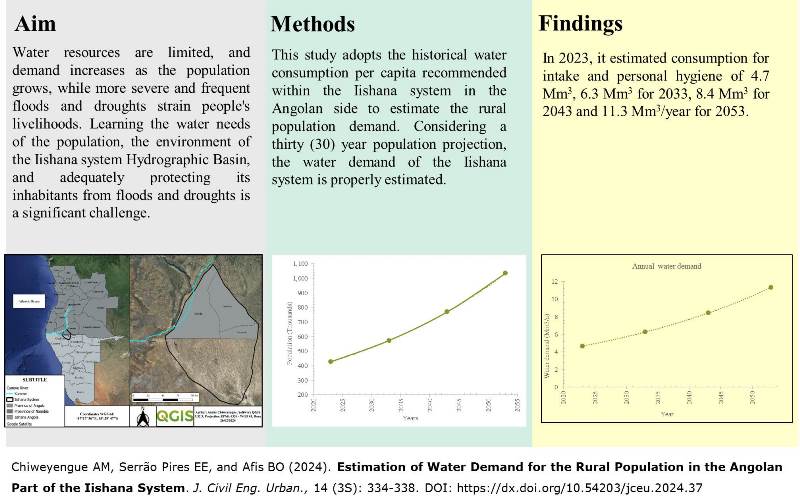 DOI: https://dx.doi.org/10.54203/jceu.2024.37
DOI: https://dx.doi.org/10.54203/jceu.2024.37
Abstract
The Iishana is a shallow, low-slope channel system located in the Cuvelai basin (Southern Angola and Northern Namibia), characterised by drought and flood cycles due to erratic climate variability. The knowledge gap regarding the actual water needs in the area, the number of residents within the system, the seasonal influence of cattle migration, and poor socio-economic conditions, make the population even more vulnerable to droughts. The main objective of this study is to estimate the water demand by the rural population on the Angolan side of the Iishana system, attempting to fill the knowledge gap. To reach the demand estimates, a mathematical procedure within a GIS environment was used, in QGIS 3.32.2 software, relating population gridded and meteorological data to make the necessary calculations. In 2023, it estimated consumption for intake and personal hygiene of 4.7 Mm3, 6.3 Mm3 for 2033, 8.4 Mm3 for 2043 and 11.3 Mm3/year for 2053. In recent years there have been rainfall records throughout the Iishana system, at an average of 518 mm/annum, but high temperatures accelerate water evaporation. Due to the topographical conditions, the waters are drained by gravity to the south of the basin (Republic of Namibia), causing a greater shortage in the dry season on the Angolan side, the study targets the estimation of water demand and the concept of rainwater harvest and sustainable water infrastructure to supply safe drinking water to equalise water demand and reduce vulnerability to climate change. These early findings may provide a basis for developing sustainable water infrastructure and use plans to improve the livelihoods of the resident population within the basin.
Keywords: Water demand, Water supply, Iishana system, Cuvelai Basin, Water infrastructure.
[Full text-PDF] [Crossref Metadata] [Export from ePrints]
<Previous issue | Next issue> | Archive

Proceedings of The International Conference on Civil Engineering for Sustainability and Resilience in the 21st Century and Beyond (ICCESR-2024)
University of Botswana, Gaborone, Botswana,
25–26 June, 2024
The International Conference on Civil Engineering for Sustainability and Resilience in the 21st Century and Beyond (ICCESR-2024), organized by the Department of Civil Engineering at the University of Botswana, brought together academia, practitioners, researchers, policy makers and regulators to discuss emerging and pertinent issues relating to sustainability and resilience in Civil Engineering and related disciplines. The conference thematic areas encompassed developments and improvements in innovative designs, construction and smart technologies and the formulation of appropriate policies in the face of climate change to ensure sustainability and resilience.
This Special Issue of the Journal of Civil Engineering and Urbanism is a compilation of the proceedings of the ICCESR-2024 conference.
ICCESR-2024 has been held as authorized partner for the Scienceline International journal (Journal of Civil Engineering and Urbanism).
Secretary, ICCESR-2024 Organizing committee
https://conferences.ub.bw/index.php/ICCESR/ICCESR-2024
Email: Oyejobido@ub.ac.bw; iccesr-2024@ub.ac.bw
Prof. Dr. Yashon Ouma
CONGRESS CHAIRMAN
Email: Oumay@ub.ac.bw
List of guest editors and reviewers
Prof. Yashon Ouma
Department of Civil Engineering, Faculty of Engineering and Technology, Private Bag UB 0061, University of Botswana, Gaborone, Botswana
Prof. Ssegawa, Joseph
Department of Civil Engineering, Faculty of Engineering and Technology, Private Bag UB 0061, University of Botswana, Gaborone, Botswana
Dr. Damilola Oyewumi Oyejobi
Department of Civil Engineering, Faculty of Engineering and Technology, Private Bag UB 0061, University of Botswana, Gaborone, Botswana
Dr. Ali A Firoozi
Department of Civil Engineering, Faculty of Engineering and Technology, Private Bag UB 0061, University of Botswana, Gaborone, Botswana
Prof. Mohammed Jameel
King Khalid University, Saudi Arabia
Prof. Modupe Jimoh
Department of Civil Engineering, University of Warwick, United Kingdom
Prof. Bolanle Ikotun
University of South Africa, UNISA, South Africa
Prof. Abdulkadir Taofeeq Sholagberu
Department of Water Resources and Environmental Engineering, University of Ilorin, Ilorin, Nigeria
Dr. Ajibola Ibrahim Quadri
Federal University of Technology, Akure, Ondo State, Nigeria
Dr. Daniel Oguntayo
Department of Civil Engineering, Landmark University, Omu-Aran, Kwara State, Nigeria
Mr. Lawrence Zahemen Tuleun
Department of Water Resources and Environmental Engineering, University of Ilorin, Ilorin, Nigeria
Dr. B. Madzikigwa
Department of Civil Engineering, University of Botswana, Gaborone, Botswana
Dr. B. Wilson
Department of Civil Engineering, University of Botswana, Gaborone, Botswana
Dr. Lopang Maphale
Department of Civil Engineering, University of Botswana, Gaborone, Botswana
Dr. B. Nkwae
Department of Civil Engineering, University of Botswana, Gaborone, Botswana
<Previous issue | Next issue> | Archive
This work is licensed under a Creative Commons Attribution 4.0 International License (CC BY 4.0)![]()




